If you’ve been a regular RevolverGuy reader for a while, you’ll probably recall our earlier coverage of the premium leather goods produced by our friends at Simply Rugged Holsters. Proprietor Rob Leahy and his talented crew of artisans are producing some really neat holsters, belts, ammo cuffs, slings, and other leather goods that are as beautiful as they are strong, and we’re definitely big fans of their work, here.
I’ve recently been working with a pair of new products from Simply Rugged that I’m excited about and want to share with you. The Sidewinder and Vertical Strip Pouch are spare ammunition carriers for revolvers, and I think they’re worth a closer look.
the ODDS VERSUS the STAKES
First, though, let’s talk about the odds and the stakes.
I think most of us would agree that the odds are against you having to—or even being able to—reload your revolver in the middle of a defensive shooting. We’ve certainly seen law enforcement gun battles (including such notable examples as Newhall and Miami) where the fight raged long enough that officers ran their guns dry and needed to reload them in extremis, but it seems that armed citizen shootings follow a different pattern, and reloads—particularly time-consuming revolver reloads–are not part of it.
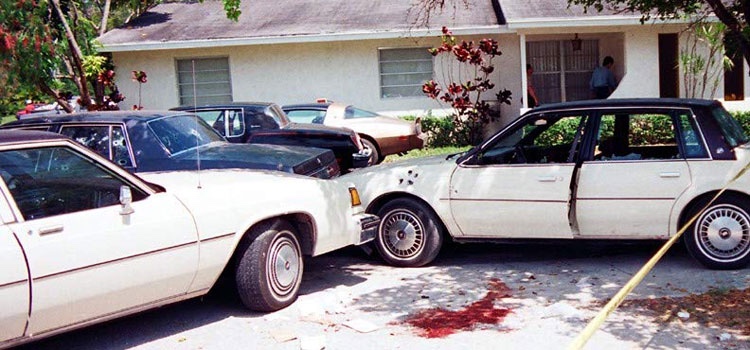
By the time an armed citizen’s gun runs dry, the players (both good and bad) have usually scattered, surrendered, or been injured to the extent they’re unable/unwilling to continue fighting. Additionally, there’s usually insufficient distance, time and cover to attempt a reload, while the forces are “on the field.”
We certainly don’t rule out the possibility of having to reload during a fight (“usually” is NOT the same as “always,” and Murphy lurks behind every corner), but we think the odds of having to do it are extremely low for the average armed citizen.
Despite this, we strongly advocate carrying spare ammunition for your defensive revolver whenever you’re carrying it. Why? Well, the odds may be against you reloading during a fight, but if you need to, the cost of being unprepared is unacceptably high. Additionally, it would be beneficial if you could reload to full capacity immediately after the fight.
In the first case, needing a reload and not having one is bad for your life expectancy. Yes, the odds are low that you would need it, but the stakes of not having it are extreme, especially since it requires such little effort to pack the reload along with the gun. If you’ve got enough space for the gun, you’ve got enough space for the reload, so don’t leave it at home. You don’t want to be hunkered down behind your car in the parking lot, or a supermarket aisle end cap, with an empty gun, while your opponent presses his attack on your position.
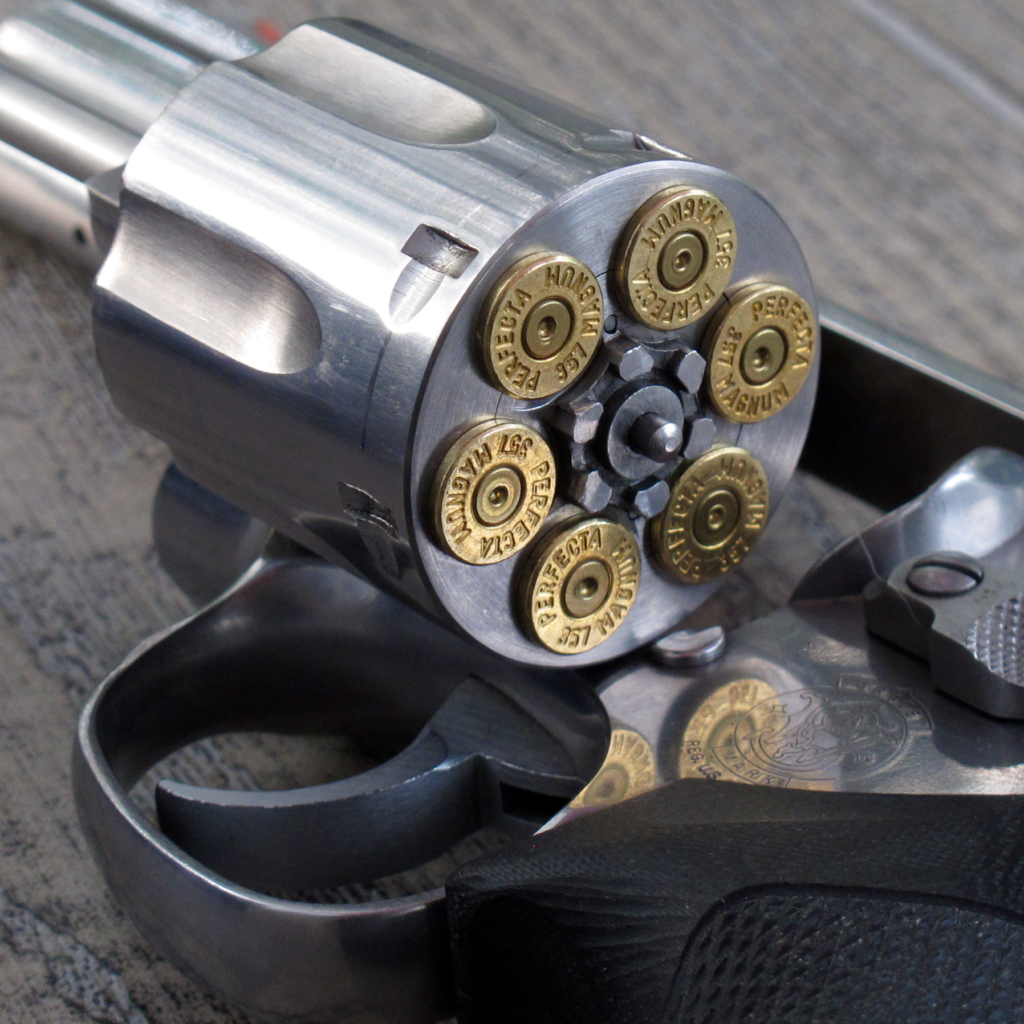
Secondly, it would be really helpful if you could reload your gun to full capacity after the first engagement is over, because you don’t know if there will be a second one coming. With bad guys running in packs as they do, it’s not inconceivable that you could get caught up in multiple fights. It’s not hard to imagine a scenario, for example, where you shoot the first bad guy, and his partner hears the noise and responds to assist/rescue him. When he shows up, do you want to be standing there with an empty, or nearly-empty gun?
Even if there isn’t another confrontation forthcoming, it will be very reassuring to know that your gun is fully loaded while you’re waiting for help to come. I’ve been told this by people who’ve experienced both sides of this coin—the ones who fretted because they didn’t have a fully loaded gun after their shooting, and the ones who were calmed by the fact that they did.
It costs so little to carry the reload, and it could save you when the chips are down, or bring some peace and eliminate unnecessary distractions after a traumatic shooting, so we think it makes sense to always have one for your carry revolver. Consider your gun and reload a matched pair.
THE SIDEWINDER
This brings us back to Rob and his new products for carrying spare revolver ammo.
The first of these we’ll look at is the Sidewinder, which is designed to carry a round-body speedloader or moon clip above the belt, in a horizontal position.
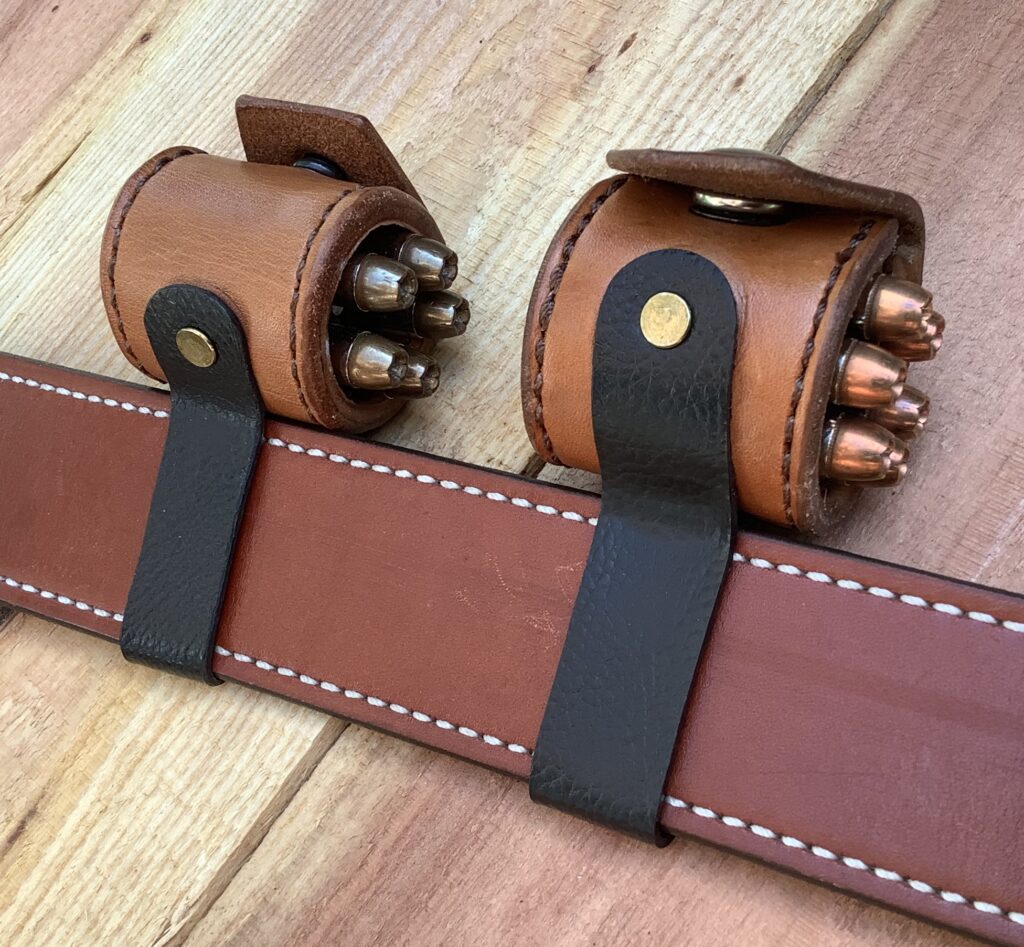
This design traces back to revolver afficionado Grant Cunningham. His wife manufactured them for a short while, but stopped before I obtained one. Crossbreed Holsters also made them for a short while, in cooperation with Grant, but their customer base was more interested in products for autoloaders, and they didn’t sell well enough to remain in the catalog.
Fortunately for us, Marty Hayes shared the design with Rob and encouraged him to bring it back to the market. It deserved another chance, and Simply Rugged was the right shop to do it. As soon as I found out that Rob’s crew was making them, I ordered one for both a J-frame and a K-frame, and I’ve been very happy with them.
So, what makes the Sidewinder so special? I’m glad you asked.
Sidewinder Concealment
The first thing is that it carries well, and doesn’t print as much as other designs when it’s concealed under clothing. The Sidewinder places half of the loader on either side of the top edge of the belt, so the concealment footprint is considerably reduced.
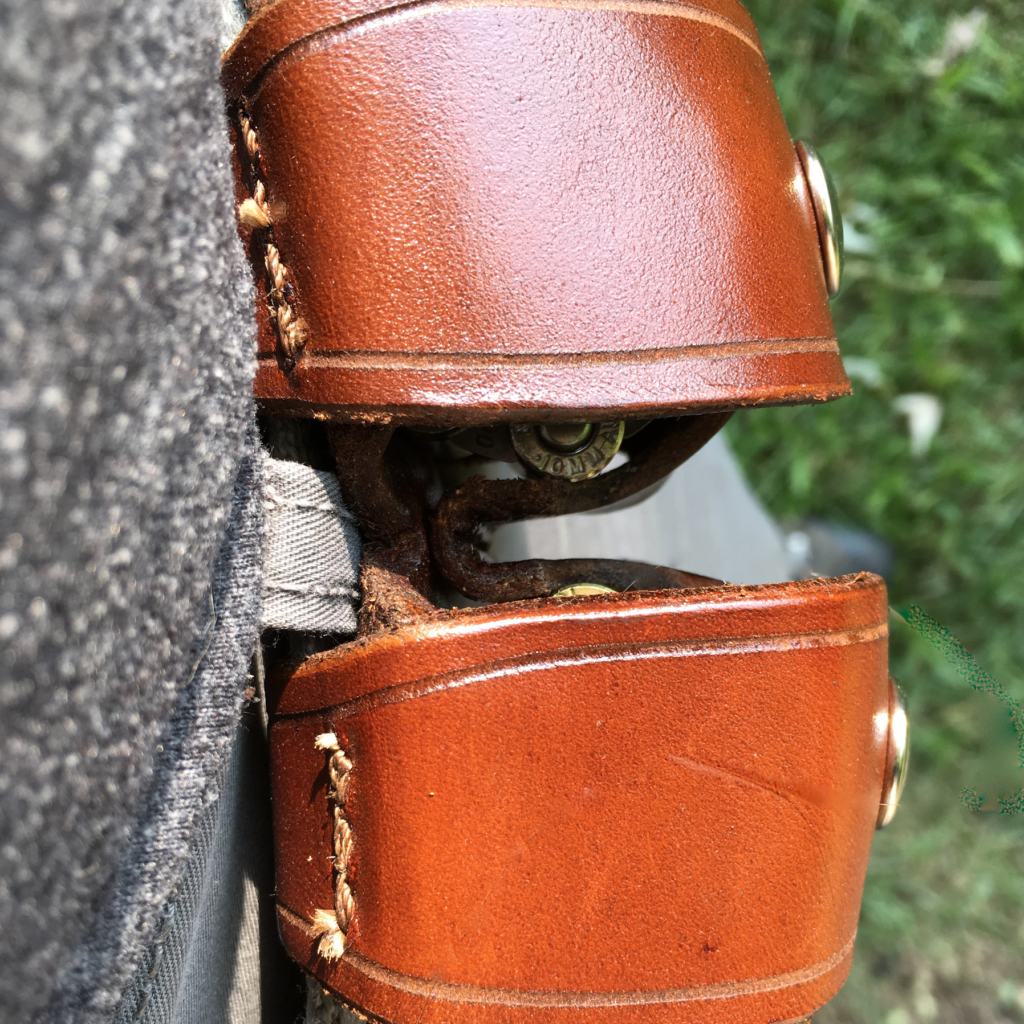
In a traditional speedloader case, the entirety of the loader is carried on the outside of the belt, and it’s wrapped in the front and back by a layer of leather, then covered with a flap. Stacking three layers of leather and the full diameter of a round body loader outside of the belt really makes the traditional case stand out, away from the body. That’s not a problem for a uniformed police duty rig, but it’s hard to hide that kind of case under a concealment garment.
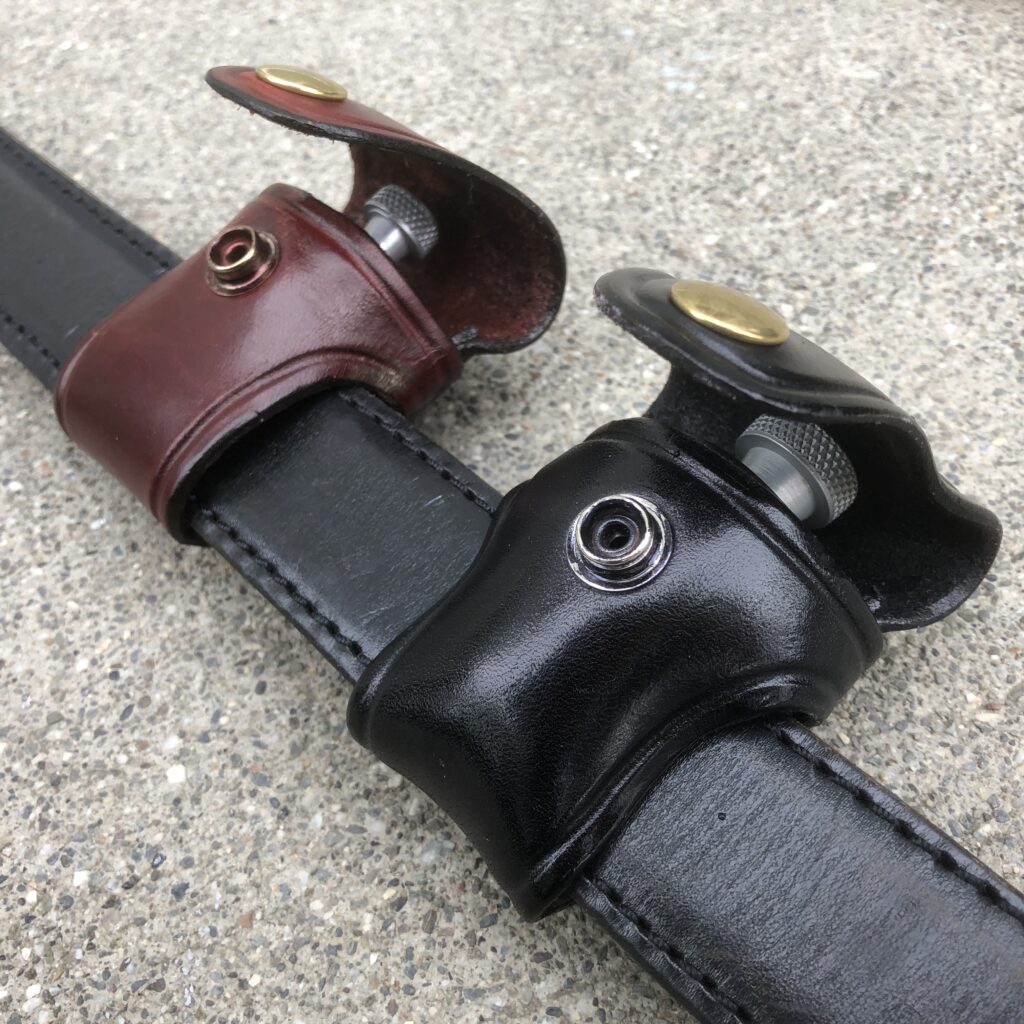
A popular approach to dealing with that problem has been to straddle the top edge of the belt with the loader, and put half of its payload on either side, as in the Safariland Split Six, DeSantis Second Six, and Don Hume Pack Six pouches. This method works well to reduce the footprint and carry the package closer to the body, but still has the downside of placing two layers of leather outside the belt (the lower portion, to hold the loader, and a covering flap to secure it), which adds a little bit of bulk.
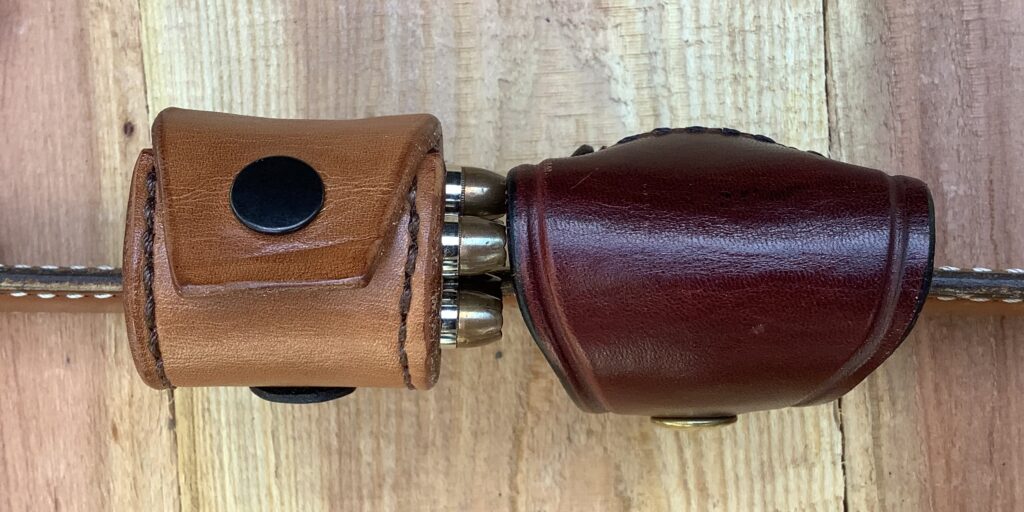
The Sidewinder carries a bit flatter, though. Besides splitting the width of the loader, the Sidewinder only puts one layer of leather on the outside of the belt, and locates the snap on top, instead of on the face of the pouch. Additionally, its tall belt loop places the loader high enough that it can nestle into the natural curves of the body. When you carry a Sidewinder on the hip, for example, it fills the area above the inward curve of the pelvis, and when you carry it in the Appendix position, it fills the area between the abdominal muscles and the protrusion of the pelvis.1 As a result, the Sidewinder can carry even closer to your body than the split-style pouches, and does a good job of disappearing under clothing—even just a t-shirt.
Sidewinder Versatility
The Sidewinder is also amenable to a greater variety of speedloader designs.
While the “split-style” pouches carry pretty flat, they don’t tend to be very compatible with push-style loaders that release their payload via a center post, like the Safariland Comp series. These push-style loaders will often discharge by accident in split-style pouches, when the post makes contact with the top edge of the belt.2 Additionally, loaders with a taller handle (like the JetLoader, Comp III, SpeedBeez and SL Variant) are often incompatible with the flaps on the split-style pouches, which are either not long enough to wrap over the top of the loader, or feature cutouts that are too small to clear the handle on the loader. As such, the best loaders to use with those pouches are the twist-style loaders from HKS, Pachmayr, or 5-Star, which are great loaders, but not everyone’s first choice.
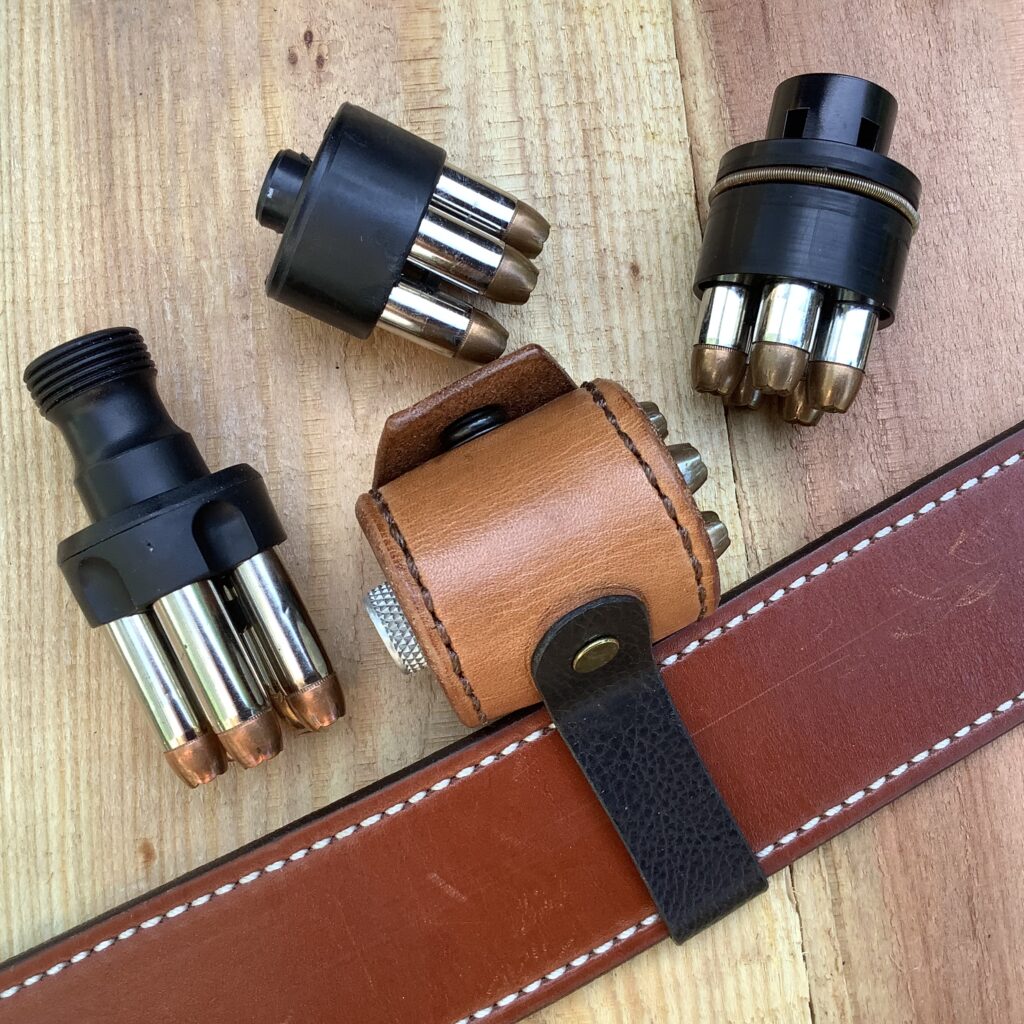
The Sidewinder doesn’t care if your loader uses a central post to discharge the payload though, and it also doesn’t care if it has a tall handle. Either will work fine, as long as the body of the loader fits snugly inside of the leather ring that encircles it.
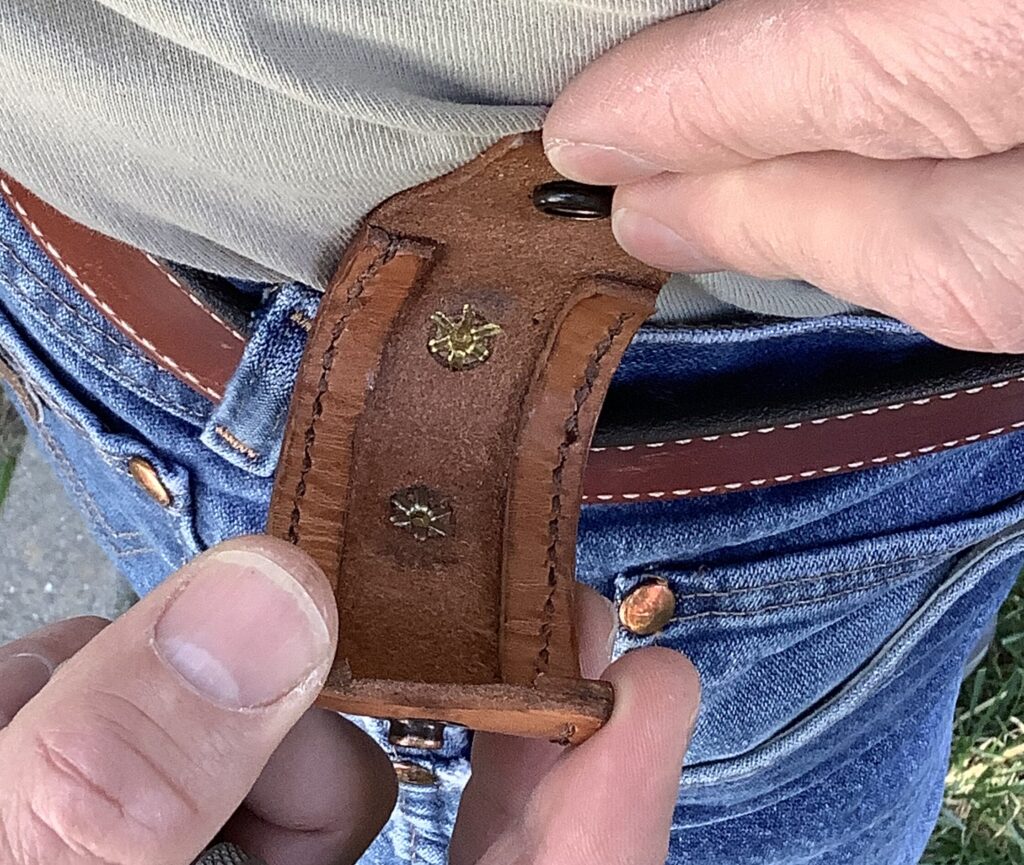
Speaking of that leather ring, there’s a recessed “track” on the inner diameter that helps to lock the body of your loader into place, so it doesn’t slide out of the carrier. I found that HKS, Safariland, SL Variant, JetLoader and Dade style loaders fit this track nicely, and suspect that 5-Star, Pachmayr, SpeedBeez, and other brands will too. It’s a great method to ensure the carrier retains the loader, and doesn’t let it squirt out the end.
Using the Sidewinder
The Sidewinder releases with a snap that can be positioned so that it pops with an inboard or an outboard push. I found that orienting the pouch for an inboard push was the best method, and reduced the potential for fumbling the loader.
I also found that carrying it on my strong side hip, with bullets forward, was the most convenient location (although I see from his website photos, that Rob likes to carry his with bullets to the rear). Carrying it to the inside of my AIWB holster wasn’t too bad, but since the loader is carried in a horizontal fashion, it needs some space for the loader handle/knob to remain clear of the holster mouth, for an unimpeded draw.
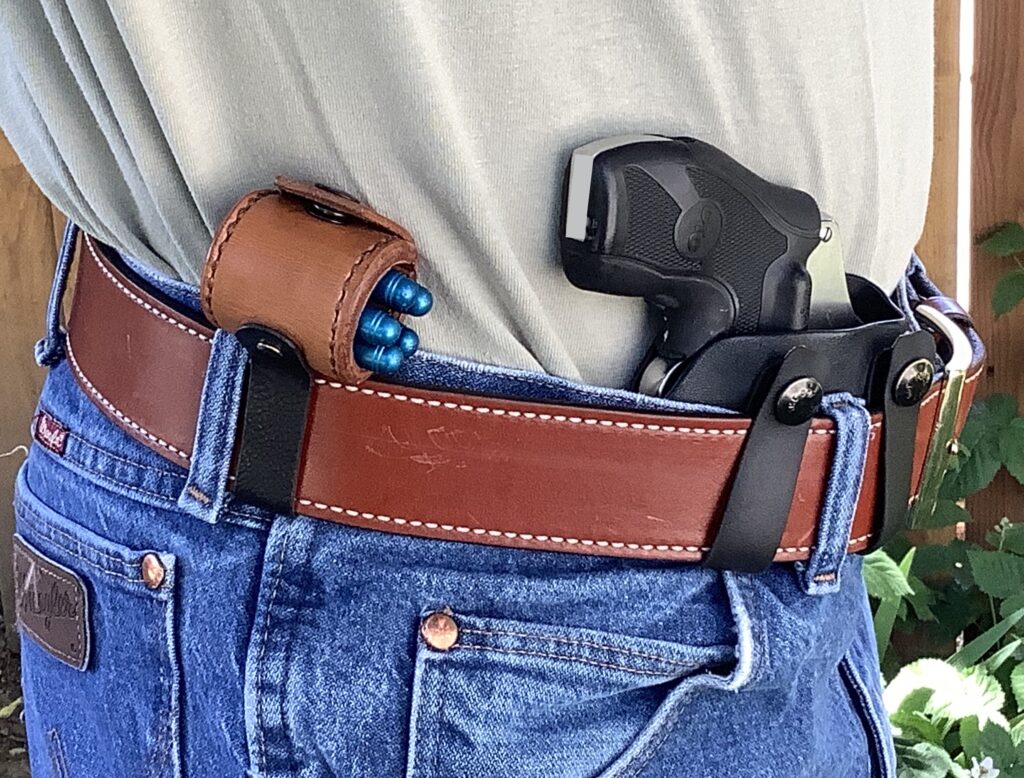
Carrying it on the strong side hip kept it from crowding my AIWB holster too much, and was also very comfortable and concealable. With its 1.75” belt loop, I found the pouch would cant a little bit on my 1.5” nylon belt, but this didn’t create any problems for me. Wearing a thicker and wider leather belt made the pouch more stable, because it fit the pouch’s loop tighter. I’m sure that Rob’s team could build your Sidewinder with a narrower belt loop, if desired—leave them a note when you place your order.
There’s a bunch of ways you could draw the loader from the Sidewinder, but here’s what I finally settled on. I approach the pouch from below with my hand, place the edge of my thumb underneath the flap, then push inboard to pop it. My fingers curl to scoop the loader out of the carrier, and I move it towards the gun. As I do, I shift it as necessary in my grip to index it with the cylinder.
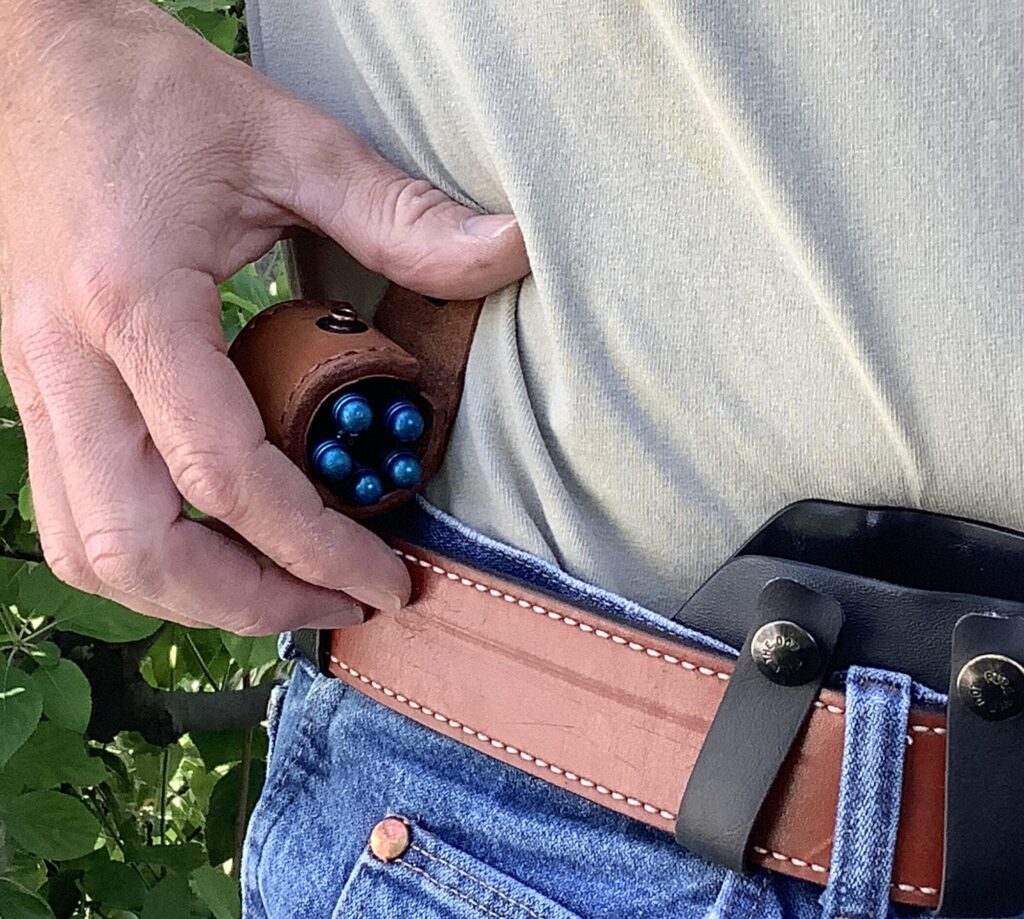
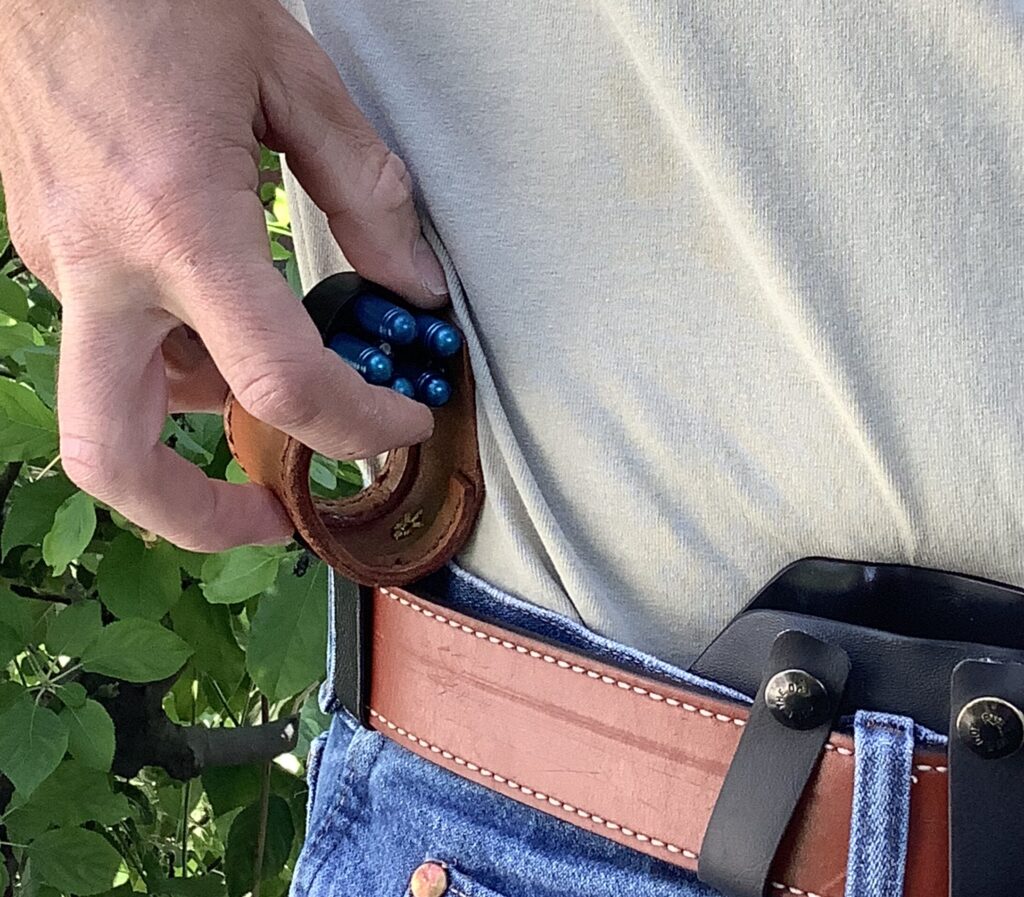
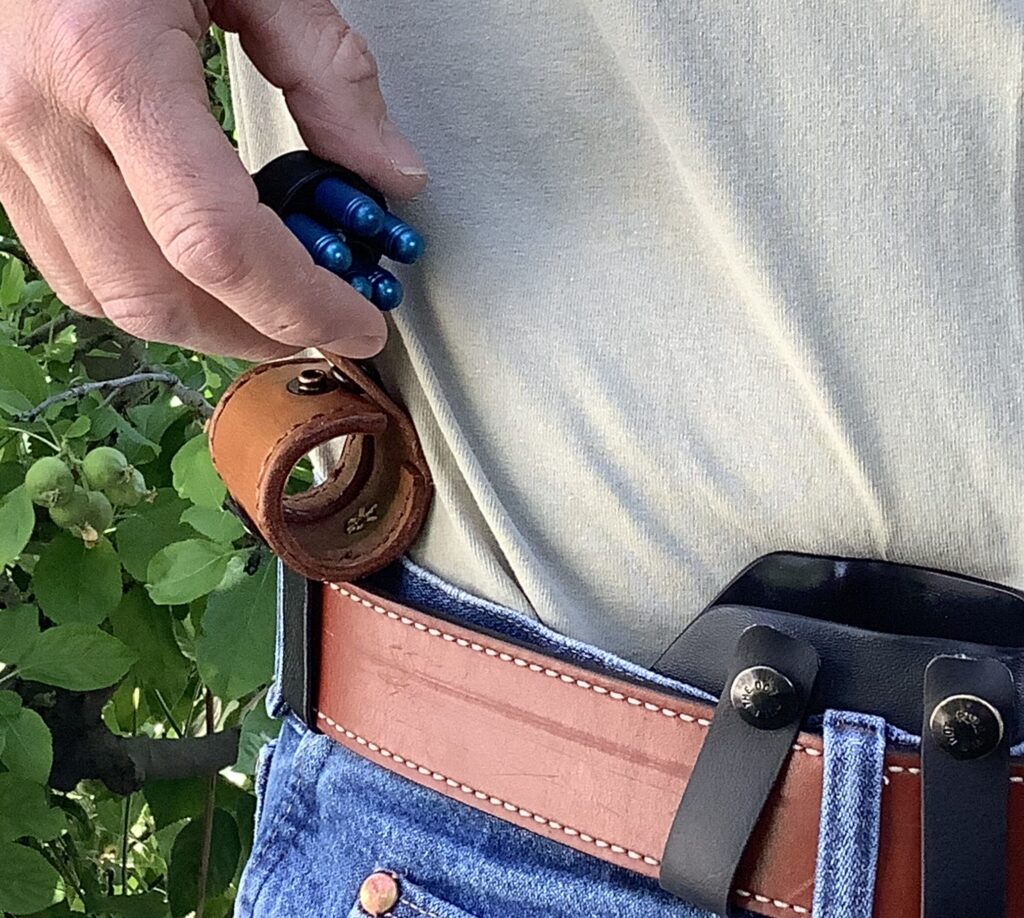
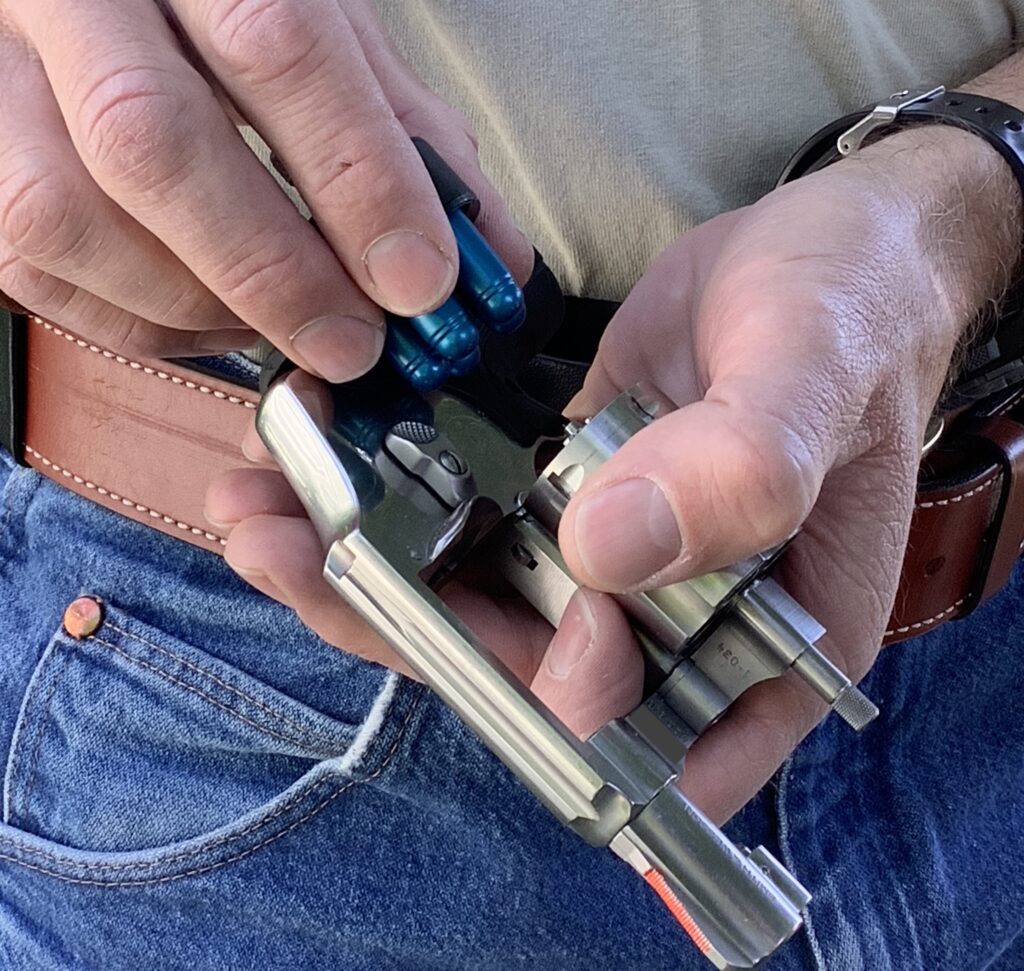
The whole process works pretty slick. Once in a while, I’ll miss the placement of my thumb underneath the flap, and when that happens, the fingertips catch and pop it, then move back down to fetch the loader. Even on these flubbed draws, the Sidewinder retains the loader nicely, and doesn’t allow it to fall out.
Sidewinder Options
Rob makes the Sidewinder for J-K-L-N sized loaders, which covers the whole spectrum nicely. You can have your choice of tan, black or oxblood coloring, and he can even stamp the leather if you’d like it with a design. As with all Simply Rugged products, the materials are top notch, and the workmanship is excellent.
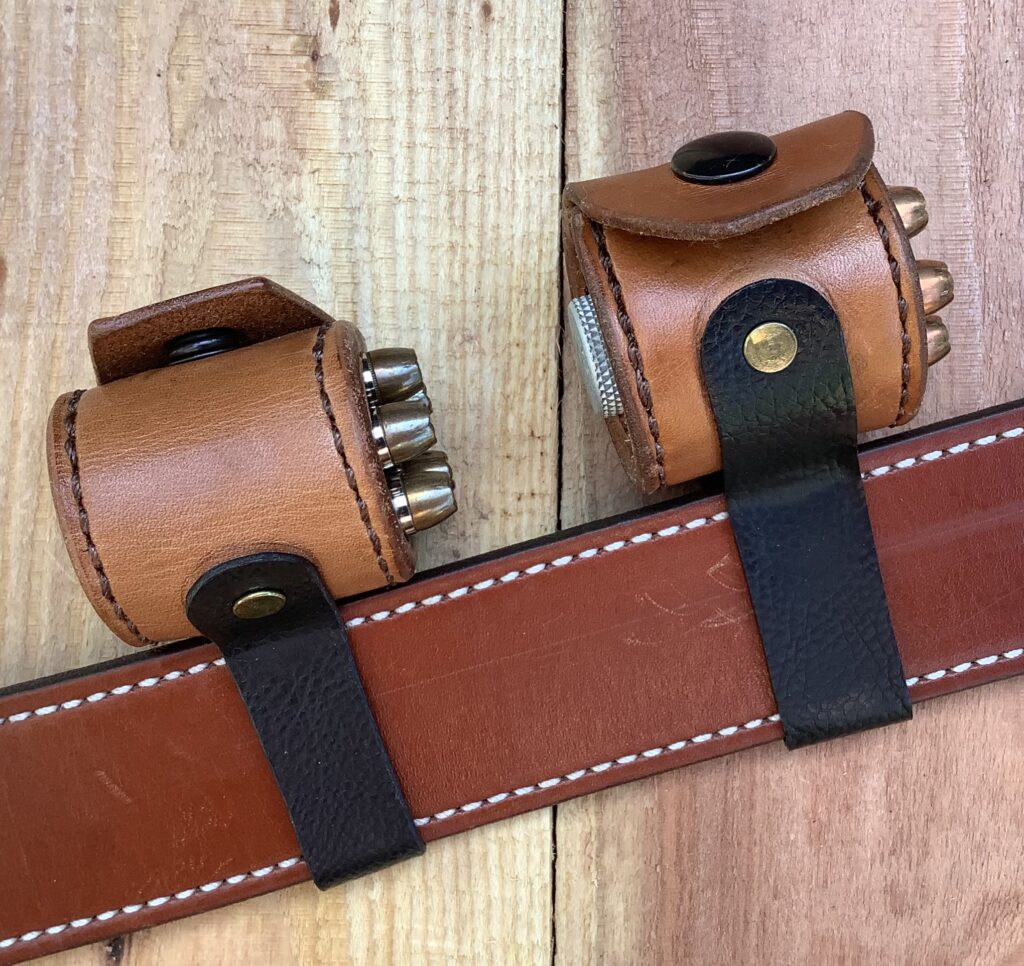
I think the Sidewinder offers a lot of advantages over other designs, and when you pair them with the quality manufacture we expect from Simply Rugged, you’ve got a winning product. I suspect the third time’s the charm for this design, and we will see it cement its place as a very popular item in the Simply Rugged catalog.
Vertical Strip Pouch
The other ammunition pouch I ordered from Rob is the Vertical Strip Pouch, which is—no surprise–designed to carry a strip loader (like a Bianchi Speed Strip or Tuff Products Quickstrip) in a vertical orientation.
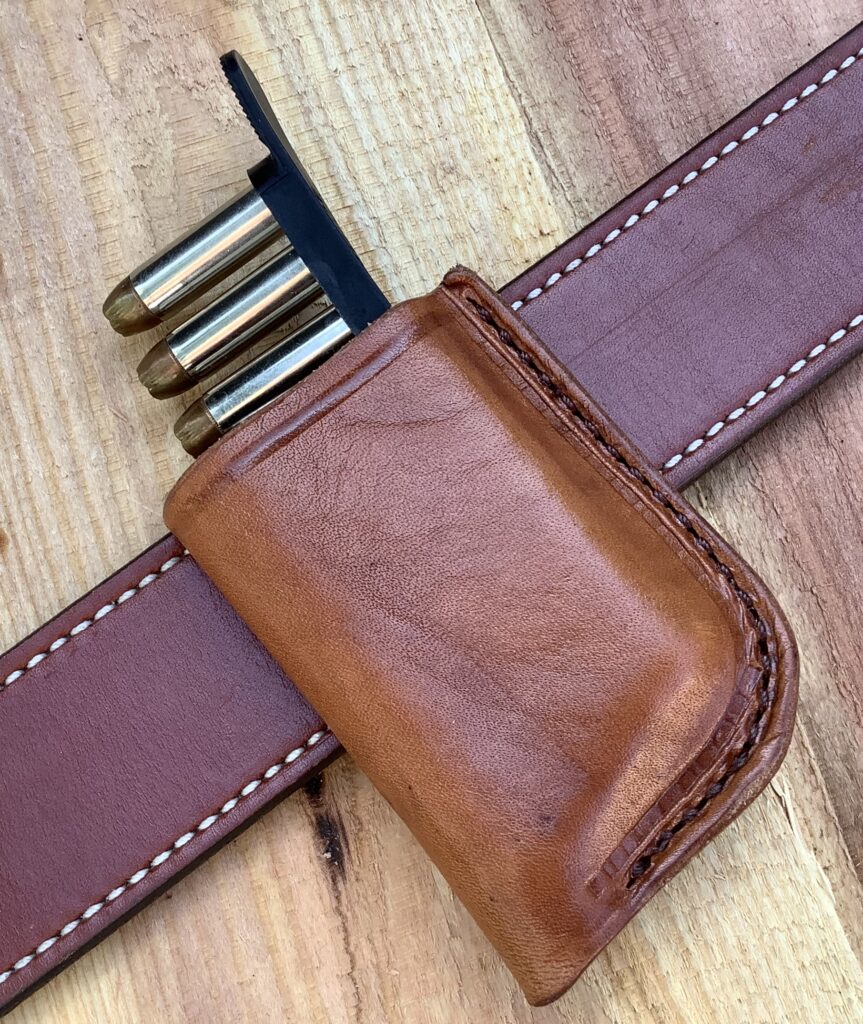
This is another one of those good ideas that didn’t make it far enough, until Rob rescued it. I once saw prototypes of this style pouch from another maker, but they decided not to go to market with them, and I was left disappointed. I guess Rob must have received some requests to make a pouch like this, and in true fashion, he simplified the design and made it tough. That sounds like something a company called Simply Rugged would do, right?
The Challenges of Packing Strip Loaders
I’d venture that 99% of us carry our strip loaders in a pants pocket, rather than putting them into a belt pouch. We’ve seen dedicated strip pouches before, from the likes of DeSantis, Tuff Products and others, but I don’t get the sense that they’re very popular, because they seem to take up a bunch of real estate on the belt, and they add bulk to a loader whose primary advantage is its trim proportions. So, most of our strip loaders just go into a pocket, and we go along with our day.
One of the downsides to tossing a strip loader in a pants pocket is that you lose the ability to put much else in there. The last thing you want to do is come up with a fist full of coins or car keys when you go diving into your pocket for your ammo, so we tend to dedicate a pocket to the loader, and not much else. With all the stuff we carry these days, it’s easy to run out of pocket real estate if one of the prime spots is taken up by your loader.
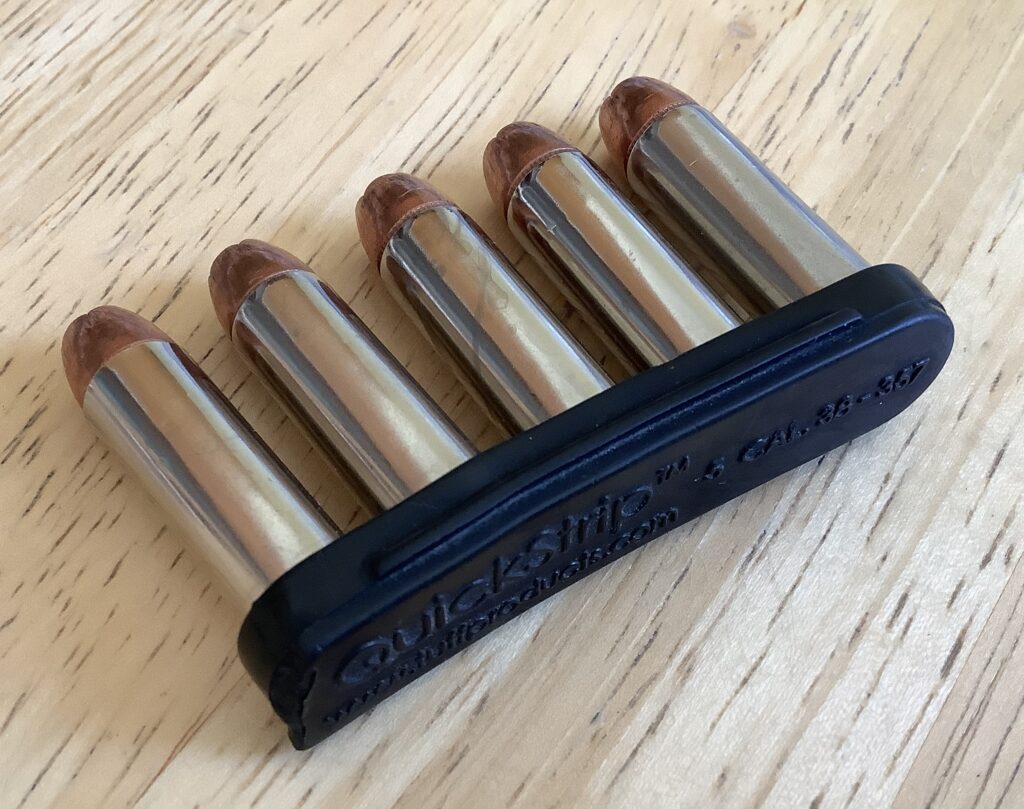
Another downside to carrying a strip loader in your pocket is the potential for damage or disassembly. I frequently have the tabs on the ends of my strip loaders break off, for example, when they get bent or torqued in my pocket (especially on the Tuff Products Quickstrip). The same motions will also peel rounds out of the loader, from time to time, leaving me with a loose round or two in the pocket.
Carrying ammo in your pocket is hard on the ammo, too. Even though I’m careful to carry them in a dedicated pocket, the cartridge cases still manage to pick up dents and dings, which limit the service life of my ammo. If you carry rounds with a soft lead bullet, it’s easy for the bullet to get deformed (I’ve seen hollowpoint cavities collapse, and flats develop on the meplat), and no ammunition, regardless of bullet type, likes to be carried in a hot and humid environment like a pocket in the summertime. We try to keep our ammo cool and dry for a reason, right?
So, while it’s convenient to carry a strip loader in a pocket, there are downsides to the practice. If only we could eliminate some of those complications, without adding unnecessary bulk to the package . . .
A Solution
The Vertical Strip Pouch does an admirable job of this.
Moving the strip loader to a dedicated belt pouch frees up pocket space and provides greater protection for your ammo.
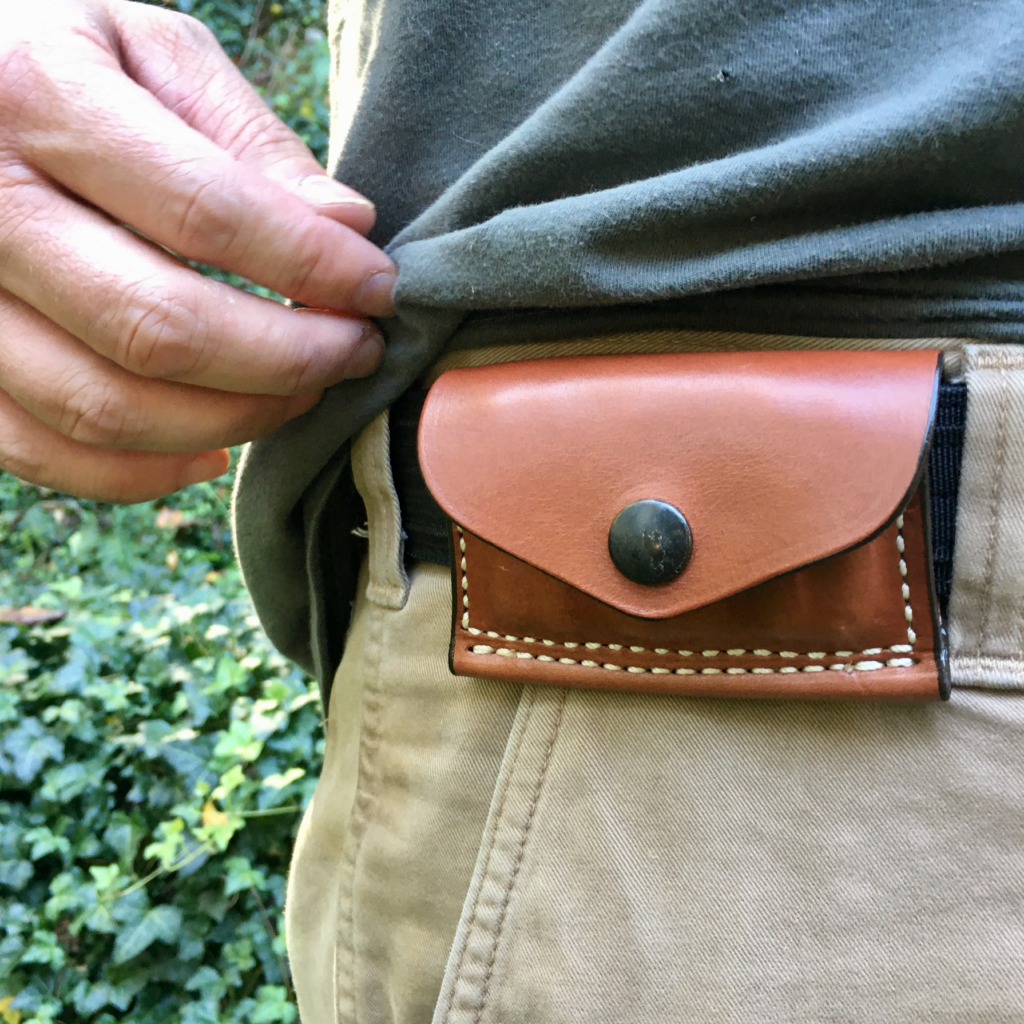
It does this without taking up much space, too. Unlike the pouches which carry the strip loader horizontally, the Vertical Strip Pouch rotates things 90 degrees, which puts the shorter dimension on the belt, not the longer one. This reduced footprint makes it easier to find a location to place the pouch on your belt, in comparison to the larger, horizontal carry pouches we’ve seen before.
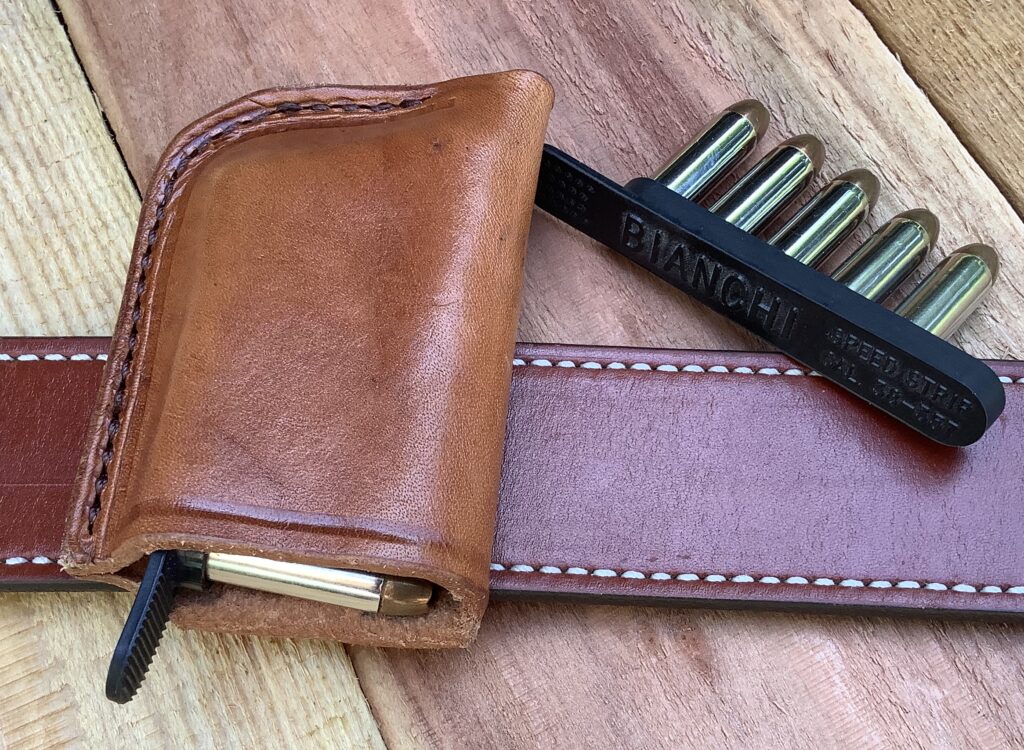
The Vertical Strip Pouch is also less bulky than those horizontal pouches, with only two layers of leather on the outside of the belt (front and back of the pouch), instead of three (front and back, plus a flap with a fat snap). This makes the pouch carry closer to your body, and reduces printing when you’re carrying concealed.
Better Access
Another advantage provided by the Vertical Strip Pouch is that it provides better, and more consistent access to your ammo than your pocket.
With a pocket-carried strip, you never know how it will be oriented when you stuff your hand in there to retrieve it. You might have to flip or rotate it before you can mate it with the cylinder and start loading, and there’s an increased potential that you might fumble it when you do so.
It can also be hard to access a pocket-carried strip sometimes. Some pockets are tight, and hard to get into, like the coin or hip pocket on your jeans. Additionally, your body position or your activity can sometimes make it difficult to access things in your pocket. Have you ever tried to fish something out of your hip pocket while you’re seated and belted into a car, for example? How about when you’re running?
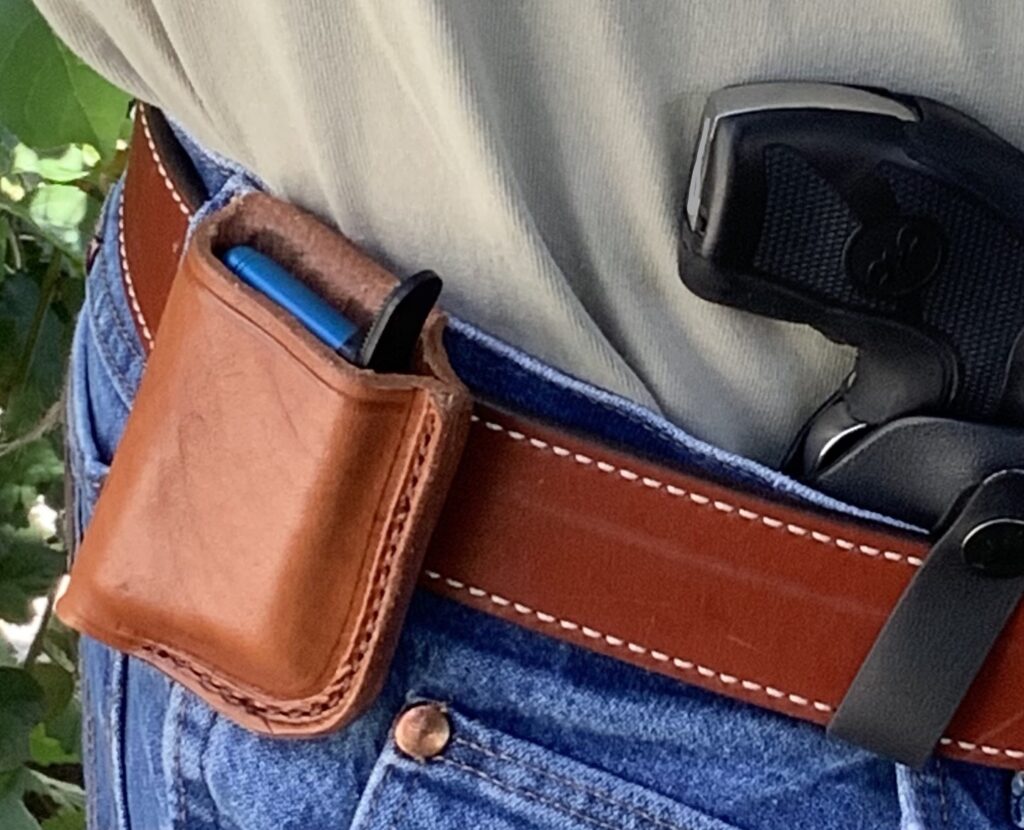
The Vertical Strip Pouch addresses these problems by presenting your ammo the same way, every time, and keeping it on your belt, where you have better access. You could draw a strip loader from your Vertical Strip Pouch while prone, kneeling, seated, or while running for cover—that’s pretty useful, huh? It’s even more useful that you wouldn’t have to juggle it to get it properly oriented with the cylinder.
Using the Vertical Strip Pouch
Once again, there’s a lot of ways you can skin the cat, but I found that carrying the Vertical Strip Pouch on my strong side hip, with the bullets to the rear, was the best fit for me.
To draw a strip loader from the pouch, I found it easiest to pinch the exposed loader tab between the top edge of my curled middle finger and the inside crease of my thumb, then withdraw the loader from the pouch. As the loader comes out, the pad of my thumb rides the spine and takes its place on the back, and my index finger clamps down on the loader, finding a spot on the tip of a bullet, or in between some of the cartridges, to anchor. With this grasp, the loader is pinched between my thumb and index finger, and I can mate the loader to the first two chambers and peel it away, then readjust my grasp on the loader to get the next two chambers filled.
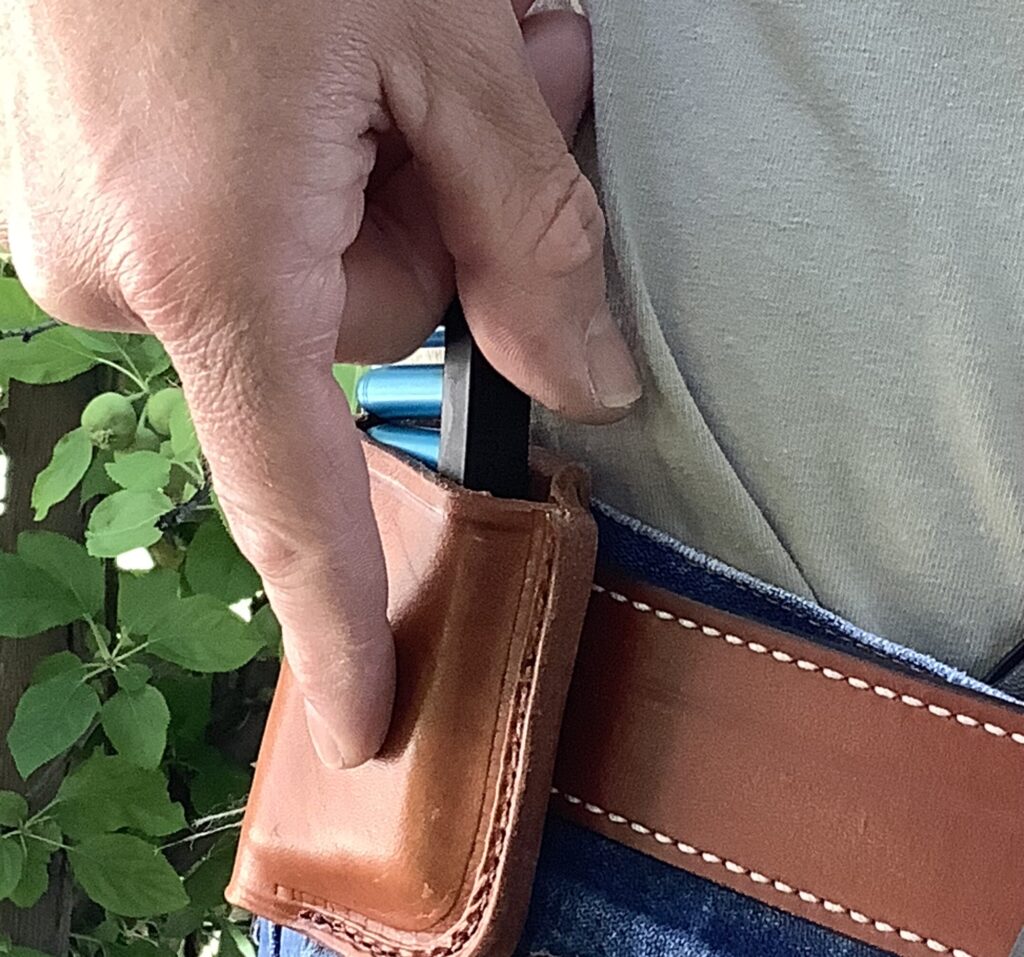
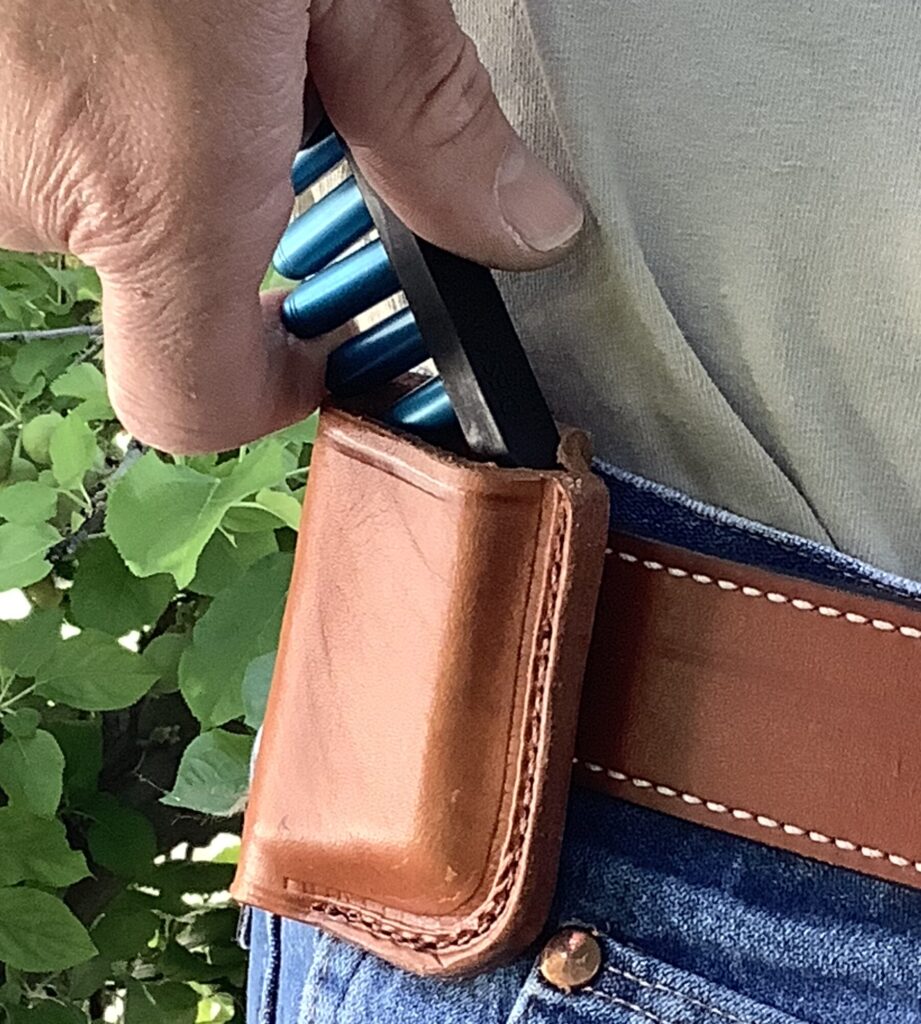
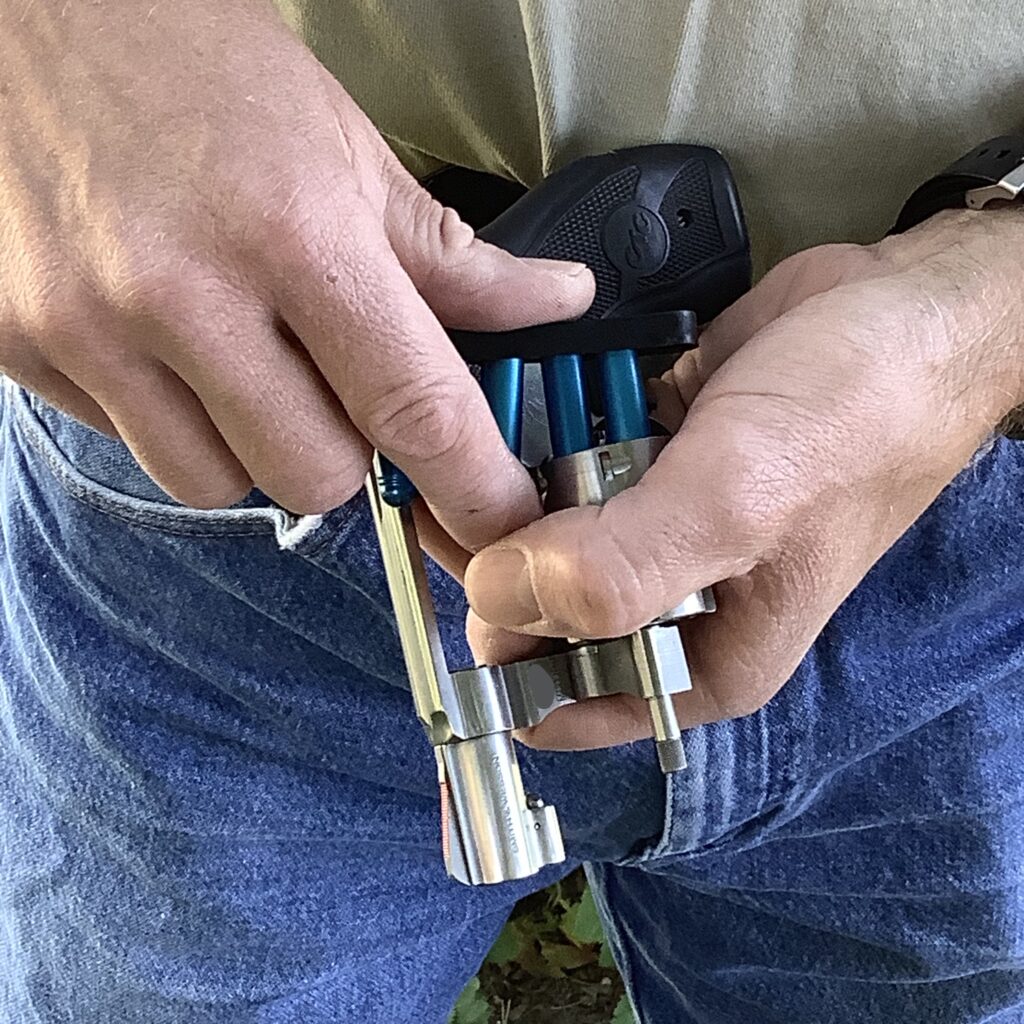
You could do the same kind of maneuver by pinching the exposed tab between your thumb and index finger for the draw, but I found it was a harder to properly index the rounds to the chambers when I was holding the loader by the end. I had to shuffle the loader and “choke up” on it a bit, to more accurately align the cartridges with the chambers, and have the thumb in the right place to do the peel away.
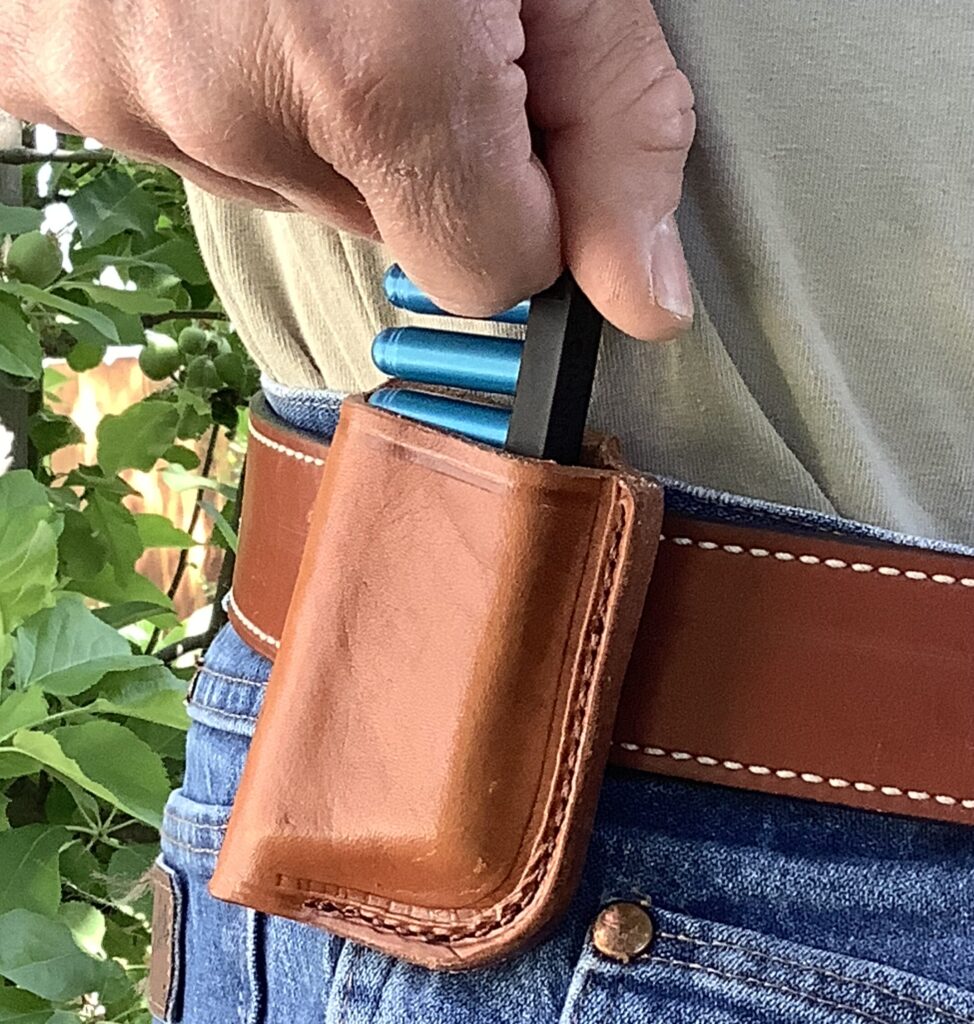
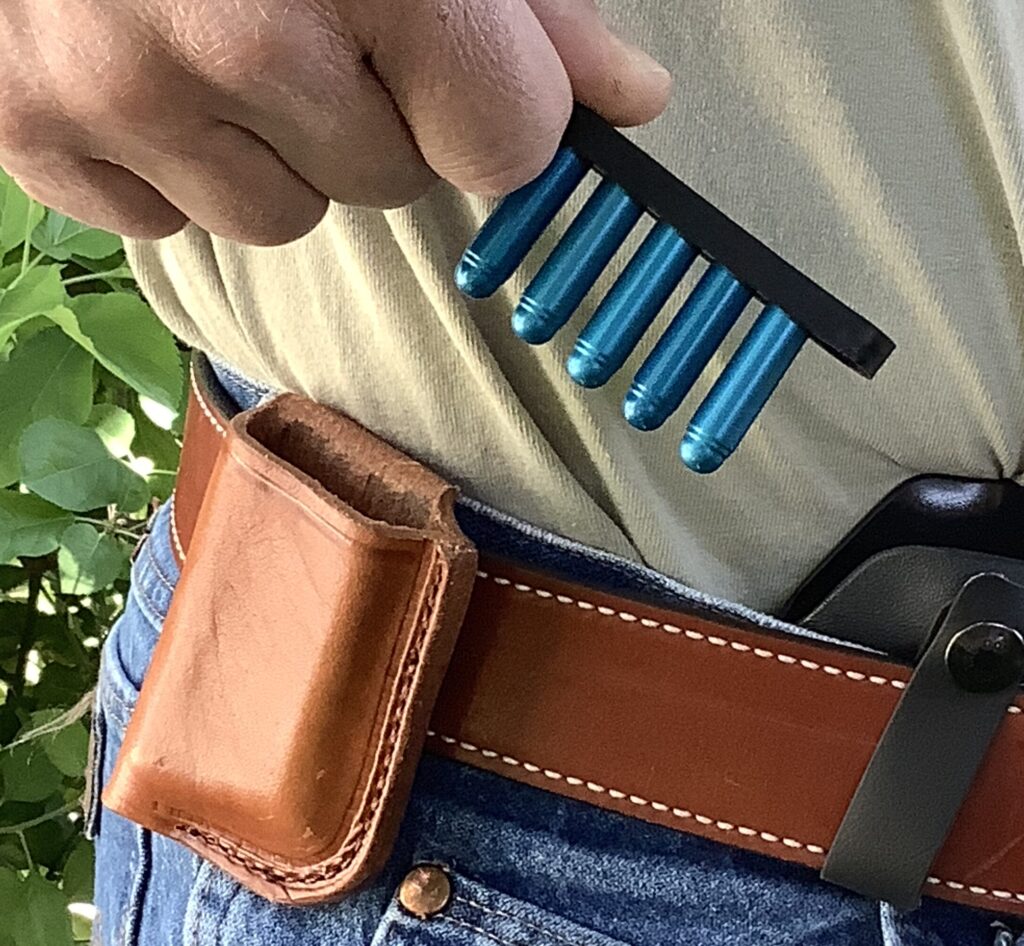
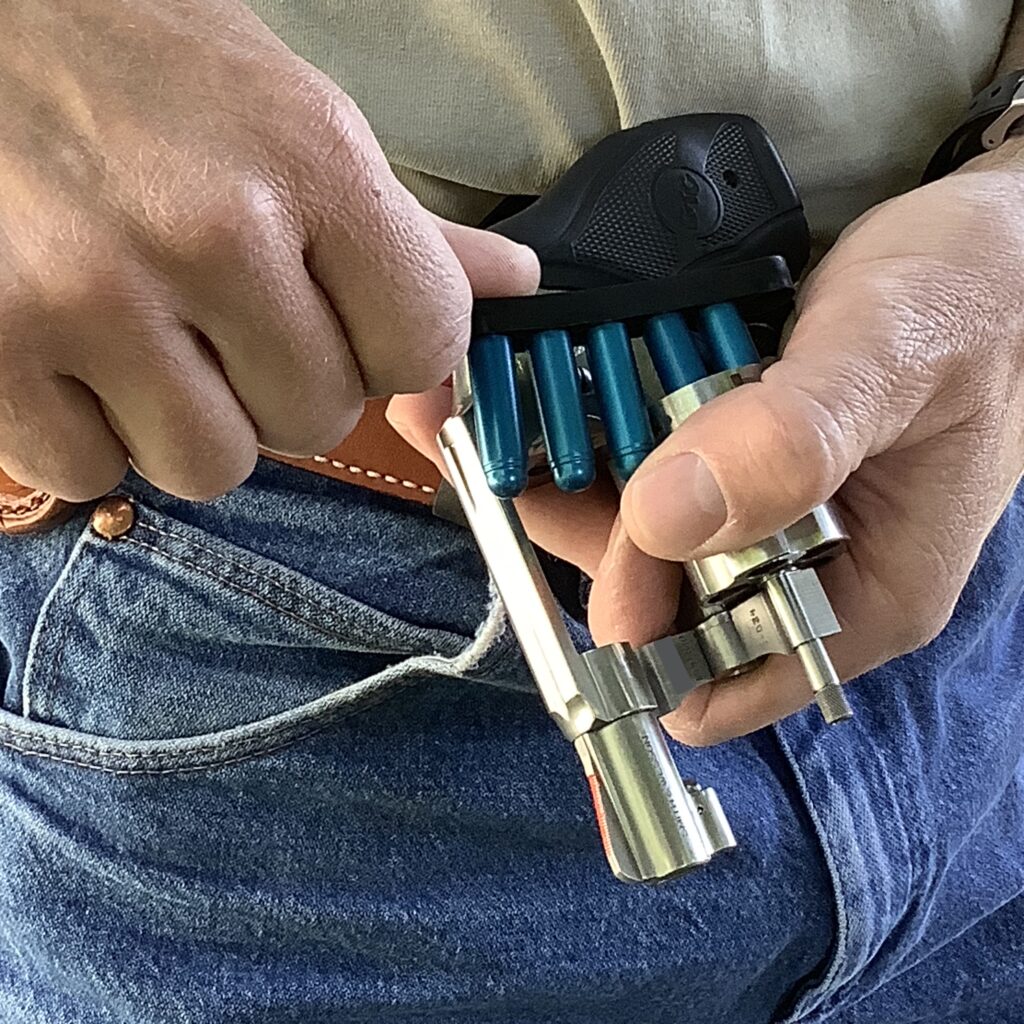
Another alternative, for those of you who prefer the “scalpel” method of loading popularized by Mas Ayoob, is to grasp the extended loader tab on its sides, between the pad of the thumb and the side edge of the middle finger, and lift it out of the pouch. As the loader comes out, you can lay your straight index finger along the spine of the loader, and get to business.
I’m sure there are other ways to draw and manipulate the loader from this pouch. If you find a better way to crack this nut, I’d be happy if you shared it with us in the comments, below.
Vertical Strip Pouch Features and Options
The Vertical Strip Pouch is offered in two sizes—one for .38 and .357 cartridges, and another for .44 and .45 cartridges. Using the shorter .38 Special cartridges made my strip fit a little sloppy in the .357-length pouch, with some extra fore-aft play that I would have liked to eliminate. The strip has never fallen out of the pouch in the course of normal activity, but I do wonder if it would stay in there if I took a good tumble. For that reason, I’d like to see a dedicated .38 Special-length pouch, with a tighter pocket—it wouldn’t take more than moving the rear seam stitch line over just a bit, to do that (and Rob might even do it for you, if you put in a special request with your order). I may experiment with putting a cardboard spacer down the inside spine of mine, to snug things up a bit, and will report back if I do that. On the bright side, the extra room makes the strip loaded with .38s come out easily, without any drag.
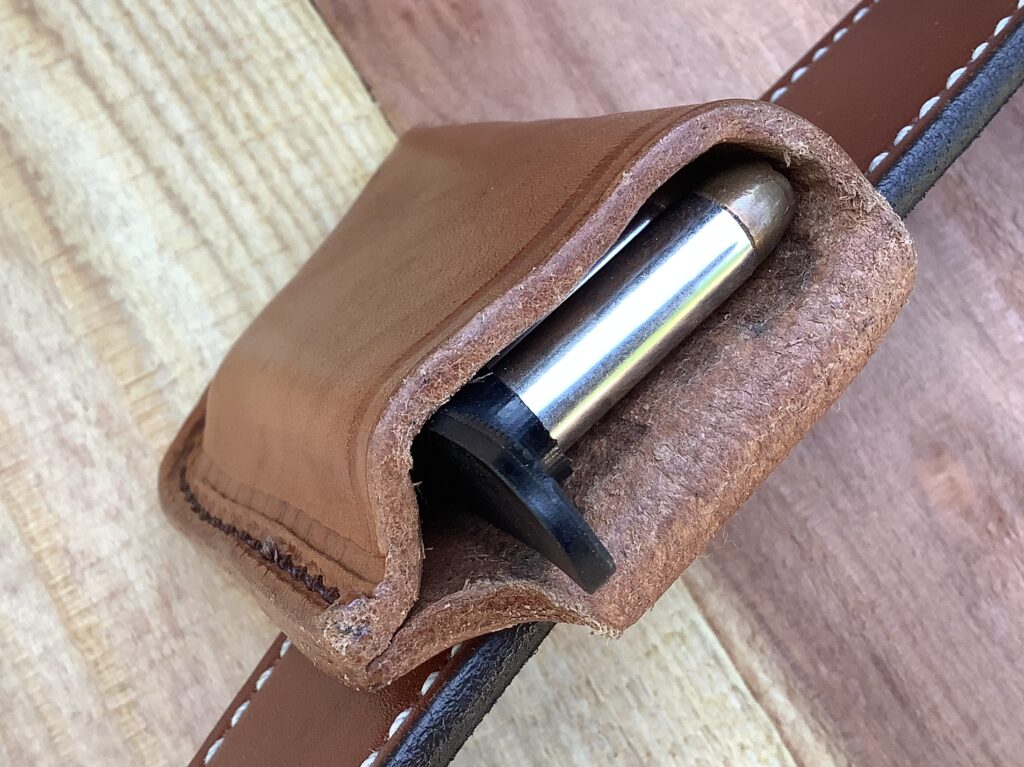
The pouch has a snapped belt loop on the back, sized to fit belts up to two inches wide. The snapped loop makes for convenient donning and doffing, and even though I normally wear a 1.5” nylon belt with the pouch, it doesn’t seem to migrate or cant much when I wear it.
Like the Sidewinder, the Vertical Strip Pouch is offered in your color choice of tan, black or oxblood. You can have border stamping, carving, basketweaving, and fish scale embossing done to match your holster and belt if you want to, as well. Rob will even sell you a package with a pair of Quickstrips added.
Wrapping It Up
To emphasize an earlier point, I think it’s important for you to carry a reload whenever you’re carrying a revolver. You may never need the reload, but if you do, it will be comforting, and perhaps life-saving, to have it on you.
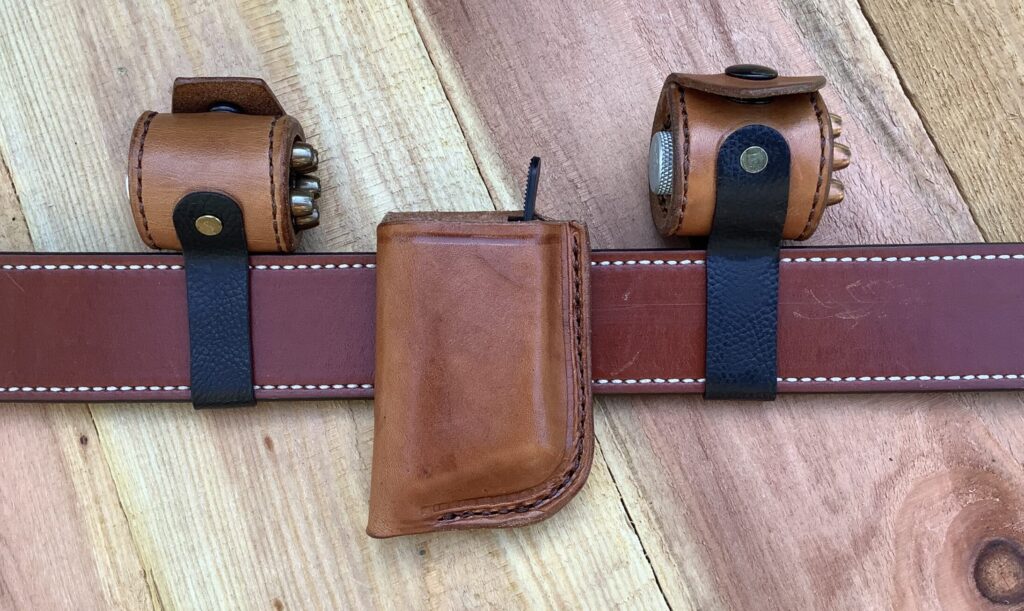
Whether your preferences turn towards using a round-body speedloader or a flat, strip-style loader, Rob and his crew at Simply Rugged have you covered with excellent pouches that will allow you to carry them in concealment and style. Run over to their website today, and check out all the options that await. I think you’ll enjoy the visit.
Make sure you tell him that RevolverGuy sent you, and be safe out there!
Endnotes
1.) Well, at least for us thin guys. You fellas with a little extra insulation might not experience the same results. ; ^ )
2.) The Safariland Split Six pouches were carefully designed to prevent this from happening, with a pinched “shelf” that held the loader above the top edge of the belt with enough clearance to minimize the problem. However, the split-style designs from DeSantis, Don Hume, and other makers don’t incorporate this feature, and allow loaders like the Safariland Comp series to rest directly on the top edge of the belt, which leads to accidental discharges of the ammo payload;

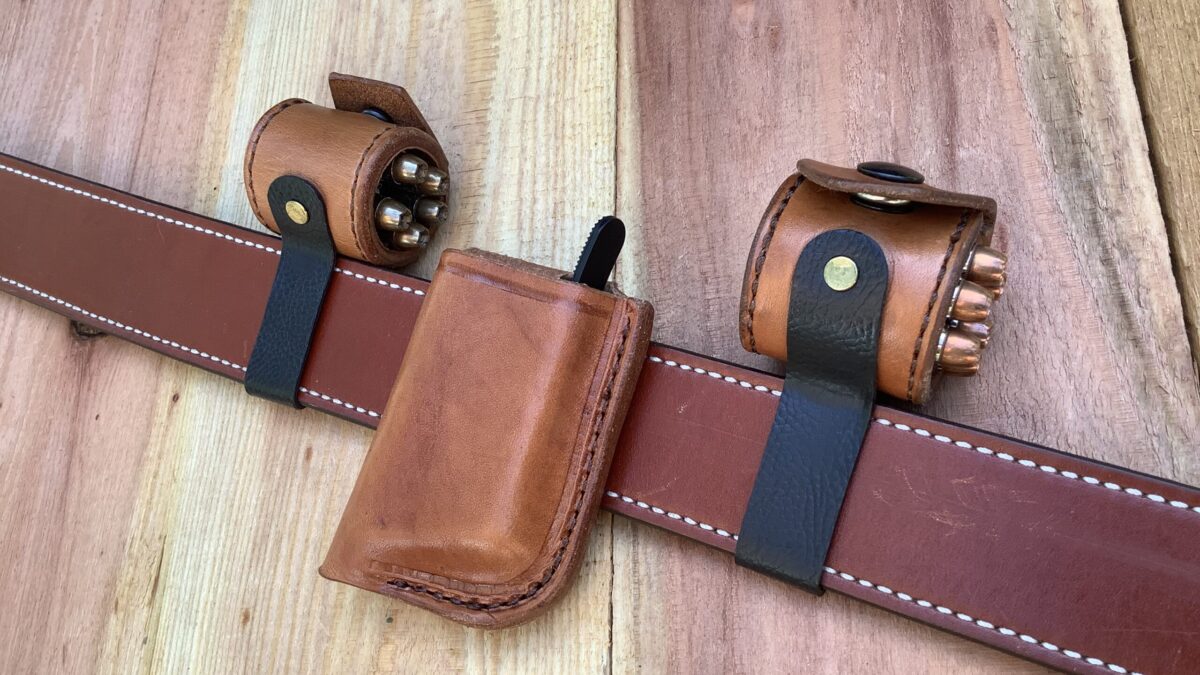
Great article Mike! For as long as I have carried revolvers, carrying extra ammunition has always been a juggling act in that I can never carry a reload in the same fasion everytime. With loose fitting clothing, a speedloader in the pocket works ok, but if I wear jeans the next day, the pockets might be too tight so I use my vintage (1980s) De Santis 2x2x2 pouch. The speedloader pouches I have work great for range use but are generally too bulky to conceal. I have been looking at Simply Rugged for a pancake style holstet for my Carry Comp 19, I think I’ll add a speedloader carrier when I make my order. Thank you again for your dedication to our beloved wheelguns!
You bet, Mark. I’m with you on that—carrying the spare ammo for a revolver is more of a tricky chore. These two pouches make it a little easier.
I always carry extra ammo when I carry a revolver, just as I do when I carry a semi-auto. For the revolver, I will carry BOTH a speedloader or two, as well as a Bianchi Speed Strip. I find that, when wearing jeans, the speed strips slip perfectly into the watch pocket on my jeans – and who carries a pocket watch anyway these days?
As an aside, one thing regarding revolvers that is seen frequently, and which really bugs me (No, I’m not going to say doing the “Cagney flip” – but that bugs me too.) is seeing folks pump the ejector rod like it was a Windex spray bottle. The ejector rod should be given ONE PUMP, AND ONE PUMP ONLY! By repeatedly depressing the ejector you stand a chance of the ejector jumping over the cartridge rim and getting pulled back into the chamber, but preventing the ejector from retracting all the way. Now your revolver is well and truly locked up until you can get a pair of mechanic’s pliers.
Tom, we’ve been fighting that one for generations, and it seems like it’s getting worse as time goes by. Maybe an artifact from people who were taught to rack slides multiple times to clear auto chambers? Maybe just a lack of good revolver training, out there? We’ll keep doing our best here to address it, as we did in our latest article on stoppages:
Revolver Malfunctions and Stoppages
Thanks for the right up Mike. I was really disappointed when I first learned of Grants design only to find out they were no longer available. Now here they are and being produced by a great company. It feels like Christmas morning. I’ll be having real soon.
I was really happy to see it, too. By the time I caught on that this might be a good idea, they were already gone. I’m happy I got a second chance to give them a try.
Good stuff, Mike. I use a Vertical Strip Pouch daily that a good friend was kind enough to send me as a gift. I knew about the Sidewinder but got sidetracked in the hubris of everyday life. Your article inspired me to go to Simply Rugged’s website and order one. Rob is having a 10% off sale in honor of this Memorial Day weekend. Everything that he and his crew make is quality; I encourage our readers to check them out.
Right on, thanks for reminding us about the sale, Kevin!
The Sidewinder looks interesting. How could it be improved? Glad you asked. I think the snap is in the wrong place. With the snap on the top, the thumb break tab stick out horizontally, where it can be inadvertently opened by rubbing against the inside of a cover garment. Ask me how I know. (I noticed that all the photos were taken with no cover garment, with the pouch out in the open air. Did you ever test it with a cover garment, especially a winter-weight one?) If you sit down or runwith a heavy coat on over the Sidewinder, the coat can grab the tab and pull it upward, potentially popping it open and dumping your speedloader. I think the snap should be on the front, next to the rivet on the belt loop. That way the flap will hang down vertically, and any cover garment rubbing against it, from a T-shirt to a parka, will tend to keep it closed instead of lifting the tab when you sit down.
Just a suggestion.
I don’t have direct experience with the sidewinder, but I made myself a “copy” of the Crossbread version at one point (I say copy in quotes, because the belt attachment was leather since I didn’t have any kydex at the time). I have also made myself a few snap-loop type holsters (one of which is my daily around-the-house holster). Having the snap on the outside like you suggest works, but is still somewhat prone to getting snagged if you raise your arms with some cover garments (I have a rain jacket – an Army PT jacket, actually – that does that from time to time). Having the snap on the top allows you to wear the Sidewinder turned opposite what is shown in the pictures (with the tab pointed towards you) and have it protected from almost any movement.
I recall that Grant Cunningham did a video explaining the snap placement at one point, but I can’t find it any more (I’m guessing it was on the Crossbread site and has since been taken down). I don’t recall what his reasoning was exactly, but I think it had a little to do with my comments above as well as (and probably more predominately) an effort to make the design hold the loader in a stable fashion in that transitional moment where it is unsnapped and the loader not yet fully controlled.
As a follow-up: Yes, you get another layer of leather on the outside of your belt, but I think the extra security is worth it.
Thanks 1811. In the winter I wore it under flannel shirts and light jackets, and now that it’s warmer, just t-shirts. I haven’t had any issues with security, so far. I can appreciate how moving the snap might afford better protection, but it hasn’t been an issue for me. One interesting thing is since the design has a bottom half that curls up and over the loader, even if the snap is popped, the pouch still cradles and holds the loader. I daresay I could probably go about my regular day with it unsnapped, and the loader would probably still be there, unless it got a really good bump.
As always, great stuff Mike, thank you.
Since my armored car days I tend to carry about five reloads… going into the check cashing place on the first of the month it meant never wondering if I had enough… I full well realize in a gunfight with that kind of round count, I probably would not survive! But I would have no hesitation about reloading.
Now, I still carry a lotta reloads. Same reason. My ready explanation for the speed loader pouch printing (have never been asked) would be “insulin pump”, hopefully that works… of course, if it goes unnoticed so much the better.
I will definitely give these items a try.
Thanks again,
Riley
“Colostomy bag” also discourages further interest. ; ^ )
That may be a better way to “go”…
Hahaha!
One brand of speedloader carrier that has been out of production for 2+ years is the “Jox Loader Pouches” by Nick Jacques, out of Pennsylvania. I have four, bought several years ago, and IMHO are the best; better than any mentioned above, and I have tried most. Easy to put on a belt, hold the speedloader securely, release easily, are thinner than ANY leather-built pouch. Not available at the time for moon clips, but that should be easy to make. The ONLY downside was the cost at about $60 each, that is why I never bought more (wish that I had!) Search the internet for past reviews and you will see that they are universally praised. (BTW, I have no financial interest in the company) I WOULD invest if they would restart production, and drop the price to $40 +/-, I think they could dominate the market.
We previously reported on them here in these pages, Chris:
RevolverGuy Jox Review
I agree they were priced too high!
Hi Mike. It may have been your reporting that persuaded me to buy. Thanks.
After going over dimensions with Nick back in… oh wow, 2017, I ended up using the HKS 587 speedloader pouches for my 625, just put some extra foam in the base to raise the top of the moonclip to the top of the pouch. They pop in and out easily.
It’s been awhile since he lost his kydex supplier, I assume it’s more the day job / life happens stuff keeping him from restarting, as the shape doesn’t seem that complex to punch out of a flat sheet. I would think it could be sourced elsewhere.
Side note here, I put on my chest rig while squirrel hunting the other day. I keep Tuffy brand strips in pouches for reloads attached to the rig. As I loaded the revolver I noticed that the Tuffy strip were rotten and tearing apart as I used it. The other 3 were in the same condition. They are about 5 years old. Has anyone else had issues with them?
Brett, I’ve carried the Bianchi and Tuff Products strips pretty extensively, and the Bianchi ones seem more durable in my experience.
I just reached out to a friend who uses the strips a lot, and he tells me all the Tuff spares that he kept in a bag, as a reserve, turned chalky and brittle, like yours. Must be something about the plastic formula they’re using.
Cloudflare hates me for some reason. But I’ll try one more time to post:
How do these work with moon clips? I’m thinking about an Alfa Proj 9mm and the Sidewinders would be the perfect companion. Let us know how this works out, if you have a chance.
Glad to see more Simply Rugged product featured. There’s a reason most of our holsters come from them.
I suspect that these would work okay with a moon clip. As noted above, I haven’t worked with a sidewinder specifically, but I did make myself a very similar pouch. The main issue I see with clips is that they are thin. The taller body of a speedloader holds it tightly between the two leather strips on the inside of the pouch body. With a moon clip, there would be room for the clip to potentially shift side to side between those strips. I don’t think a clip would fall out (though I could be wrong), but it seems like an increased chance of the clip getting bent due to the extra movement that it would allow.
Wheelgunner, the only moon clips I have here are for the 9mm Ruger LCR, and the J-frame Sidewinder is too big for them. They pass right through and fall out, when the snap is closed. I suppose a clip for a different gun or caliber could work, but I think Rob’s Full Moon Pouch would be better for the job. I would also recommend the moon clip pouch I previously reviewed from Jeffrey Custom Leather, here.
These pouches look good. High-quality leather and stitching. The leather is thick, too thick for my preferences, but at least it’s not kydex. I prefer nylon pouches. Nylon can be less durable (sometimes) than leather, but it’s less expensive and easier for me to clean. Comments by some gunners frequently jump to labeling all nylon gun stuff as “cheap nylon pouch” or “cheap nylon holster” or “cheap nylon” fill-in-the-blank. My strong dislike of kydex leads me first to nylon then, if needed, leather. Nylon is lighter, quieter, and more malleable for me. High-quality ballistic nylon is best for me. Nylon may require replacement more often depending on use, but that’s OK for me. There’s nothing wrong with leather for those who prefer it. The pouches above are too bulky for me. Thank you for presenting these products.
You bet, Ron. We’ve all got different preferences and needs, so there’s no universal solutions. The nylon gear does indeed clean up easier, and it’s durable enough to give a decent service life. It also doesn’t squeak like leather can, when it’s new. Leather has its own advantages, and I generally prefer it, but that doesn’t mean it’s the best for everyone and every job. Thanks for reading!
I find that when I try to put loose rounds in the “change” pocket of my jeans my watch gets in the way.
Ha! You mean, your “timepiece?”
You covered Simply Rugged’s holsters so well in your April 2 article of this year, Colonel, that no questions remain for me, but I’ll add a personal update concerning the company’s pocket holster.
It was at least six months ago when I bought Simply Rugged’s plain jane pocket holster and it’s been an excellent product, one that I wear almost every day. Coupled with my air-weight snubby, I often forget it’s riding in my pants, even when I frequently walk to and from the grocery store, about a four-mile round trip from my crib.
The holster’s thick leather (my preference) still looks new, and having an extra two rounds tucked in its rear skirt is comforting.
Probably there are other good pocket holsters out there, but I’ve only experienced Simply Rugged’s. You won’t go wrong if you buy one.
Thanks Spencer! I always love to hear feedback about the products we review and recommend. I love my SR pocket holster too. This is the time of year that it will start to get a real workout.
Sadly, the Safariland Double Split Six appears to be ‘out of production’. Fortunately I have two very well used (and abused) ones, along with Sam Andrews’ version of the same concept. Safariland had the snaps on the side, Sam’s has the snaps on the top. Both work very well. I also have several Bianchi ‘nylon’ double speedloader pouches that have a lot of miles on them. I found the nylon Bianchi accumold pouch actually works a bit better upside down, so releasing the snap drops the loader in my hand.
The speed strip pouch brings back fond memories of my first duty rig, with dual dump pouches for .357 Magnum. I learned quickly in the academy to despise the pouches, and surmised that the guy at GHQ who authorized these had never actually tried to use them. The pouches were a real PITA to keep clean inside. I always wondered why we didn’t have the belt loops that were used by nearly all the county SOs and most local PDs . . . the belt loops were actually faster to work with, and given the heat, humidity, and salt water environment, would have been easier to maintain. The concept of the dump pouches – when they worked – was pop the snap at the bottom, cartridges fall into your hand, and voila, you reload. That was when it worked, and assuming Murphy wasn’t behind you causing mayhem.
Speedloaders, like HKS, had already been out on the market, but were verboten on the duty belt as they weren’t “uniform”. This is where the speed strips came into play. A number of us upstarts would take the dump pouches and stretched them so six .357 Magnums on a speed strip would slide up inside comfortably. The tab would be folded under the pouch flap for inspection, then before we hit the road, we’d release the speed strip tab so we could actually get to it if needed, and hope the last round didn’t snag.
Mike brought up the horizontal cartridge pouch, and yes, it may take up real estate on the belt, but it has a much larger access area. In my brain, being able to get your mitts on your ammo supply and actually execute the reload is far more important than a bit of space on the belt.
There is always the concern over having to reload, and taking incoming fire, etc. Newhall and Miami still occupy the minds of those on the job in those years. However, in the 25 years of revolver carry, I only needed to reload once – and it was an after action recharge. At my age, I look for ways out, try to avoid anything that suggests conflict, and am eager to try for a new world record for the old geezer’s 400 meter sprint outta there.
Same in the CHP, Stuart. The dump pouches gave a neat and uniform appearance, and that’s all that mattered to the bosses. Performance be damned. The clever officers found ways to stretch the pouches to hold more rounds, and eventually, rounds on strips, just like you did.
I haven’t seen Sam’s split-style pouch and will have to investigate. Everything he does is solid.
Not bragging, but I don’t have much real estate on my waistline, so I run out of space to put things, real fast—particularly because some back issues make it difficult to carry from 3:00 to 5:00. There’s nothing wrong with a horizontal pouch if you’ve got the room. I like the 2x2x2 pouches better than the strip pouches, in that format.
Thanks for the data point about the frequency of in-fight revolver reloads. That’s very useful. Like I said, I won’t rule out the possibility, but think the odds are slim that most of us will have to reload a revolver under fire. I think we’re more likely to run out of time than ammo.
I’m definitely with you on the avoidance strategy!
On the real estate front . . . I’m laughing, given we’ve met up many times . . . but to achieve a body like mine took lots of work. To achieve this, it has involved years of neglect, irregular physical exercise regimen, poor diet (midnight shift truck stop cuisine or stake out fast food), and overall physical abuse have contributed to me having the body that’s a deep fried double wide version of what I was in my 20s to 50s. I can’t believe I once wore a 32′ duty belt.
Haha! I’ll get there someday, too. The thing I can look forward to is having plenty of room for extra gear! ; ^ )
I’m getting there too! It’s taken time, but I’m achieving a protective covering for the rock hard abs!
; ^ )
Thank you Mike for this article. No matter how old we get never stop learning. Never heard of the jox loader carrier. Sorry they are not in production any longer. The Sidewinder looks like a good idea.
The Tuffy strips are terrible everyone I have ever purchased crumbles.
Have had good luck with belt pouches that are pick two style.
Thanks Tony, I appreciate the extra data point on the Tuff Strips. I’ve seen some well practiced guys do amazing work with 2x2x2 pouches, and think they’re very useful. I wouldn’t hesitate to rely on one.
Been carrying two speed strips in a Remora magazine holster in my pocket. Works pretty good but is just one more thing in the pocket. The leather speed strip holster is now on my Fathers Day list….
Tell them we sent you!
I remember when Grant Cunningham came out with these. Great idea and I’m glad someone is running with it. Can’t help but think that if the loop were made of a stretchy material like neoprene, one size would stretch to accommodate multiple frame sizes.
Over the years, I’ve found that both Tuff strips and Bianchi strips are limited-life items in terms that they age out and fall apart. Just last week, I pulled an old strip out of the back of a handgun safe that had probably been in that fairly constant environment for a decade, as it was tucked back in the corner unnoticed. It came out in three pieces and fell apart in my hands. When the little finger tab starts to tear off or one of the cartridge holes starts to tear, it’s time to replace that strip. They are pretty inexpensive.
Since carrying a reload for a revolver is the definition of an optimist, I optimistically replace my carry strips every 5 years.
Personally, I like the Bianchi strips better as they are bit more flexible and, in cold environments, don’t become as firm as the Tuff strips. When temperatures get down well below freezing, I’ve found the Tuff strips don’t like to bend and release their cartridges while the Bianchi will still do so.
Good stuff, Bill. I live in a pretty mild climate and the wintertime temps rarely get below the 30s at the time of day I’d be outside, so I don’t have much experience working with the strips in freezing temps. I prefer the Bianchi strips and find they last longer than the Tuff Products ones. I actually think TP may have changed their formula somewhere along the way, because the recent reports indicate a shorter lifespan than what I’ve experienced with my older Tuff Products strips.
I always carry at least two reloads when I carry a revolver. Usually one is on an HKS speedloader an the other is on a Bianchi speedstrip. The speedloader is in a Hume Pack Six, and the speedloader usually slips into the watch pocket of my jeans – and nobody carries a pocket watch these days anyway.